50 Wild Animals in India [Wildlife in India]
Want to know more about the wildlife in India?
Discover 50 wild animals in India in this post, as well as interesting facts about them. 🇮🇳
Learn All About Indian Animals
Ready to learn all about Indian animals?
I’ve always been fascinated by animals, and by how they can be so different from one country to another. In this guide, we’ll focus on the many animals India has on the land, in the sky, and underwater.
I’ve split the guide into 4 categories:
- Native animals from India
- Endangered animals of India
- What is the state animal of India?
- How many animals native to India?
Let’s dive in right away with our first category!
Native Animals from India
India is an Asian country located in the southern part of the continent, on its own subcontinent. It is the seventh-largest country in the world, and it used to be part of Africa during Pangea: its collision with Asia created the highest mountain chain on the planet, the Himalayas. It is bordered by Pakistan, Bangladesh, Myanmar, China, Nepal, and Bhutan, and it is near the Maldives and Sri Lanka; although its largest city is Mumbai for the city itself and Delhi for the metropolitan area, its capital city is New Delhi, which counts more than 249,000 inhabitants (but more than 28,514,000 if you include its metropolitan area!).
An interesting part of the country that I wanted to tackle is its wildlife. In light of that, I have listed the best of it, and I hope you will love learning what animals live in India.
Here’s the India animals list.
1. Bengal tiger
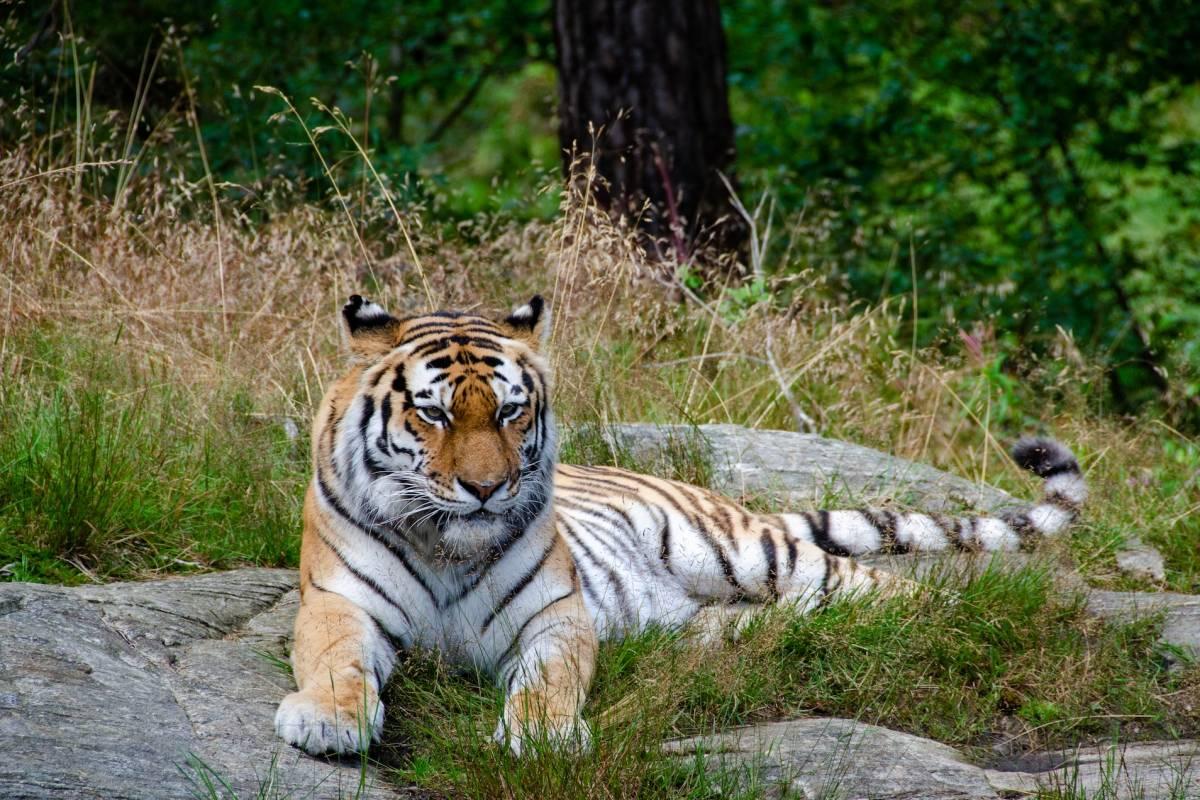
- Name: Bengal tiger
- Scientific name: Panthera tigris tigris
- Conservation status:
The Bengal tiger is easily the symbol of India. It is one of the largest wild cats in the world and is part of the world’s charismatic megafauna.
It has been living on the Indian subcontinent for about 12,000 to 16,500 years and is only threatened nowadays, by poaching, habitat fragmentation, and poaching. There are fewer than 2,500 wild individuals left, and it has disappeared from much of its former range.
2. Himalayan black bear
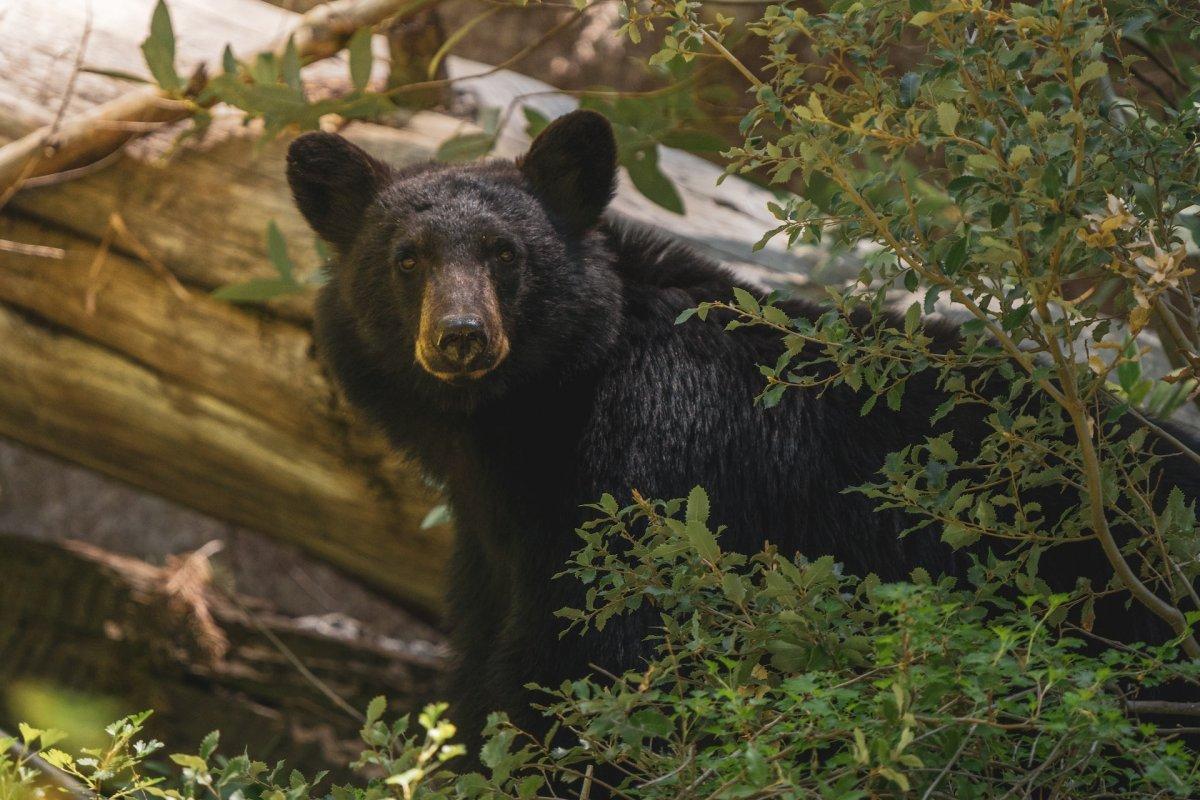
- Name: Himalayan black bear
- Scientific name: Ursus thibetanus laniger
- Conservation status:
The Himalayan black bear is a subspecies of the Asian black bear, native to India, Bhutan, Nepal, China, and Pakistan. It has long, thick fur and a small white chest mark.
During the winter, it descends at about 1,500 m / 5,000 ft, while it usually lives at altitudes between 3,000 m and 3,700 m / 10,000 to 12,000 ft in the summer.
3. Gharial
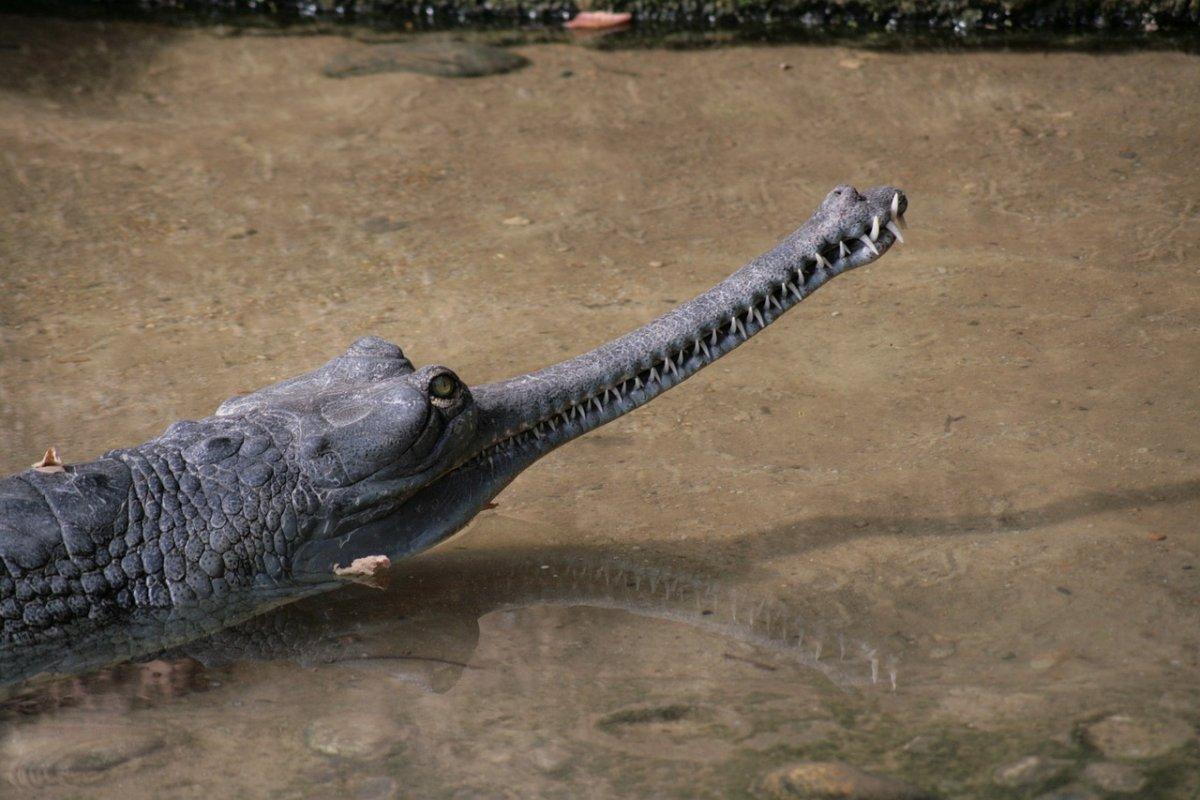
- Name: Gharial
- Scientific name: Gavialis gangeticus
- Conservation status:
The gharial, also known as the fish-eating crocodile or the gavial, is one of the longest species of crocodilians in the world. It gets its name from the Indian earthenware pot “ghara” because of its boss at the end of the snout that looks like it.
This reptile is sadly on the brink of extinction: its current range only represents about 2 percent of its historical one, and it is severely threatened by habitat loss, agricultural expansion, and fishing practices.
4. Snow leopard
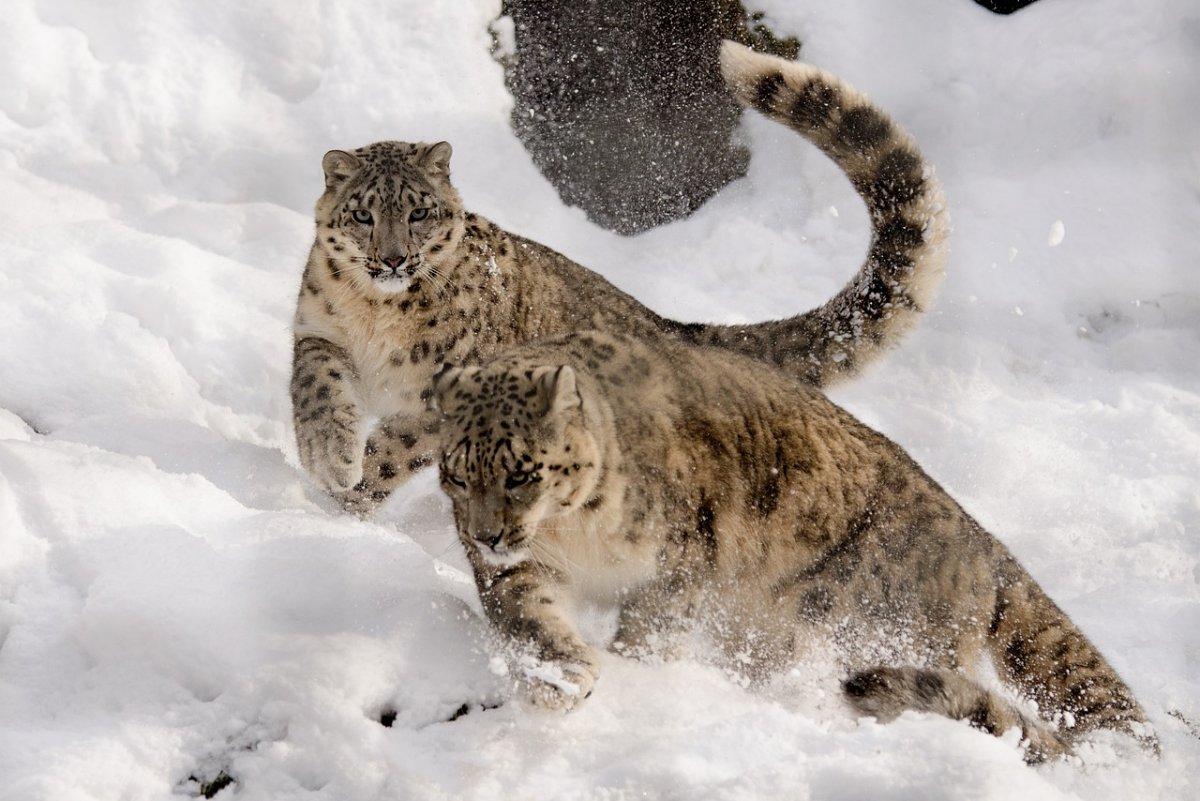
- Name: Snow leopard
- Scientific name: Panthera uncia
- Conservation status:
The snow leopard, also known as the ounce, is a species of felid native to the mountains of Central and South Asia, and one of the most well-known large animals in the continent. It lives in alpine zones at altitudes of 3,000 to 4,000 m / 9,800 to 14,800 ft.
Fewer than 10,000 mature individuals remain, and its population is expected to further decline by almost 10 percent by 2040, mostly because of urban expansion and poaching.
5. King cobra
- Name: King cobra
- Scientific name: Ophiophagus hannah
- Conservation status:
When thinking about India, the king cobra is probably one of the first animals that come to mind. It is a venomous snake species endemic to Asian jungles, in the southern and southeastern parts of the continent. It is the national reptile of India.
While it has a fearsome reputation, it usually avoids conflicts with humans when possible. However, when seriously provoked, it can attack from a long range and well above the ground, and it usually injects a large quantity of venom, which requires immediate medical attention.
6. Chinkara
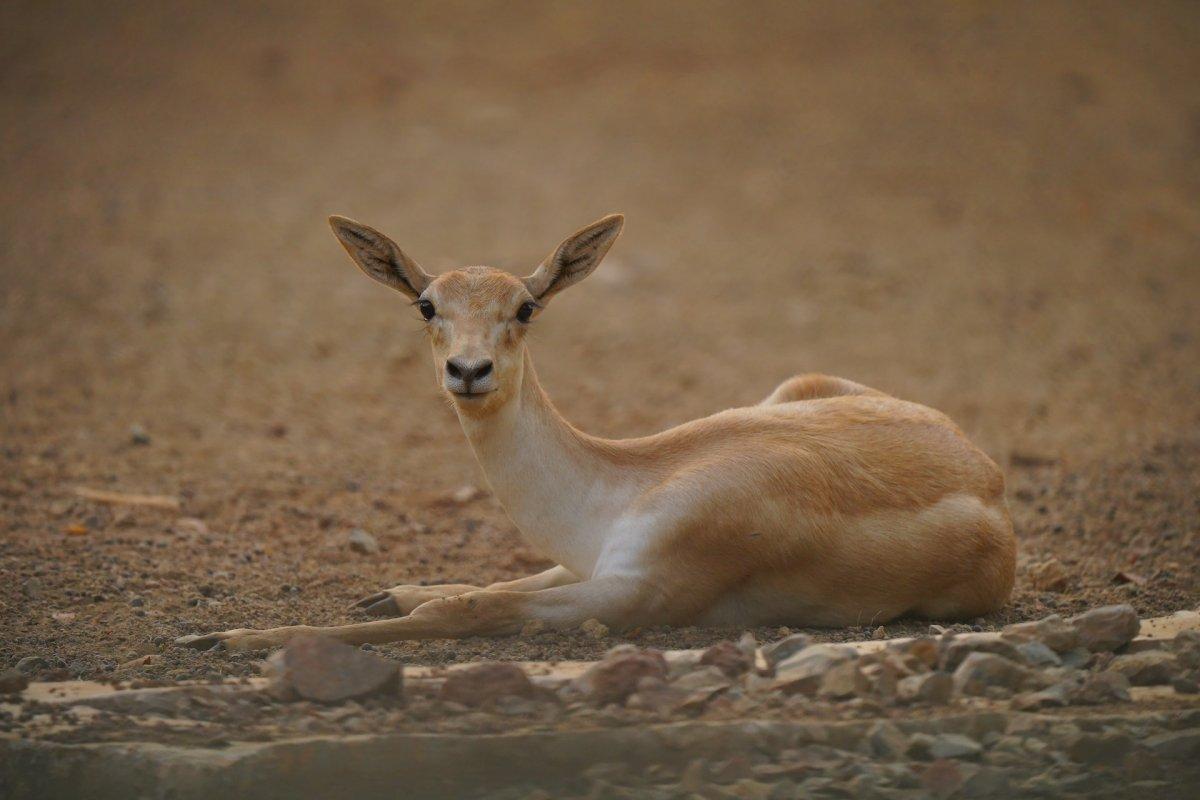
- Name: Chinkara
- Scientific name: Gazella bennettii
- Conservation status:
The chinkara, also known as the Indian gazelle, is a species of gazelle native to India, Iran, Pakistan, and Afghanistan. Despite India’s most famous animals living in dense jungles, the country also has vast steppes, ideal for gazelles to thrive.
The chinkara usually avoids human confrontation and is quite shy. It can survive without water for a long period of time and find enough fluids in plants and droplets.
7. Indian peafowl
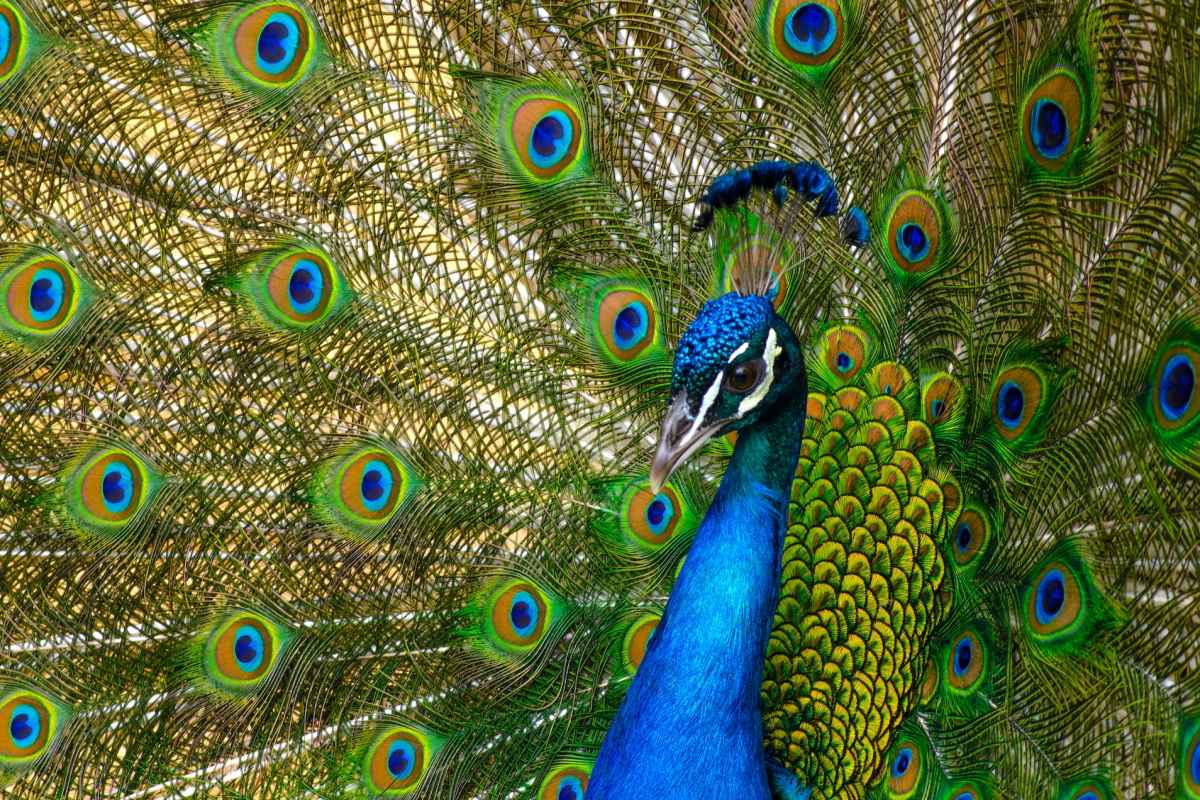
- Name: Indian peafowl
- Scientific name: Pavo cristatus
- Conservation status:
The Indian peafowl, also known as the blue peafowl or the common peafowl, is a species of bird native to the Indian subcontinent. Widely called the peacock, which is actually only the name of males (while females are called peahens), it has been introduced in many countries in the world.
This bird species has a unique, splendid train it often displays. The reason for that is debated, as it could be for sexual selection, but could also be a handicap.
8. Pygmy hog
- Name: Pygmy hog
- Scientific name: Porcula salvania
- Conservation status:
If you have never heard of it, you missed out! The pygmy hog is a species of suid native to the Himalayas, at altitudes of up to 300 m / 980 ft. There is only one known population nowadays, which is located in India and maybe southern Bhutan.
There are less than 250 mature individuals left in the wild, and the pygmy hog is considered endangered. To save this species, some conservation programs were launched, and are helping by releasing individuals in the wild.
9. Reticulated python
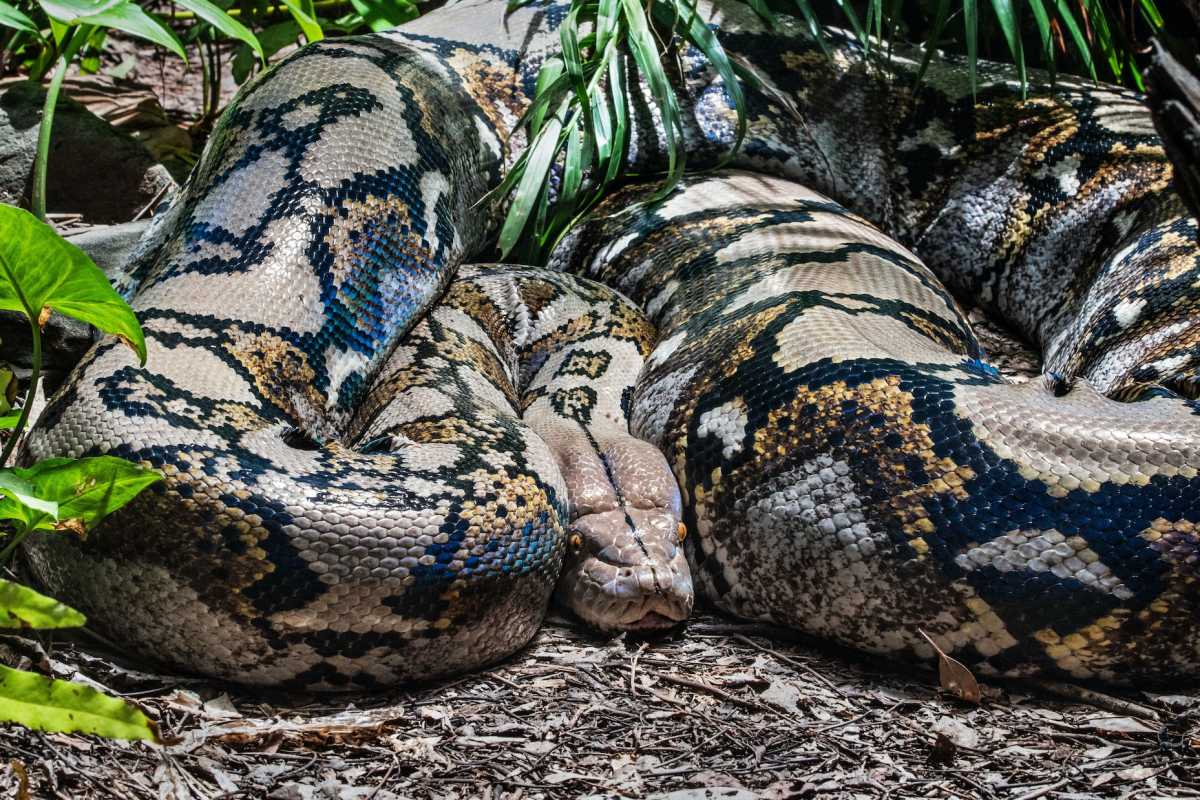
- Name: Reticulated python
- Scientific name: Malayopython reticulatus
- Conservation status:
The reticulated python is the most famous species of python, and one of the most well-known snakes, being the longest one in the world. With a wide distribution, it is considered of least concern; however, the reticulated python is often hunted for its skin, for sale as a pet, or for use in traditional medicine, which are its biggest threats.
The other interesting features of this snake are that it is not venomous, but rather a constrictor (that can kill and eat adult humans), and that it is one of the three heaviest snakes in the world.
10. Indian hog deer
- Name: Indian hog deer
- Scientific name: Axis porcinus
- Conservation status:
The Indian hog deer is a small species of deer native to the Indian subcontinent, in a narrow stripe from Pakistan to Bangladesh and western Thailand. Its name derives from the way it runs, similar to a hog, with its head hung low.
This deer only lives within groups when conditions are favorable, and they usually run away in separate directions when alarmed. Their main predators are the tiger, the clouded leopard, and the leopard, as well as the dhole and the Burmese python.
11. Burmese python
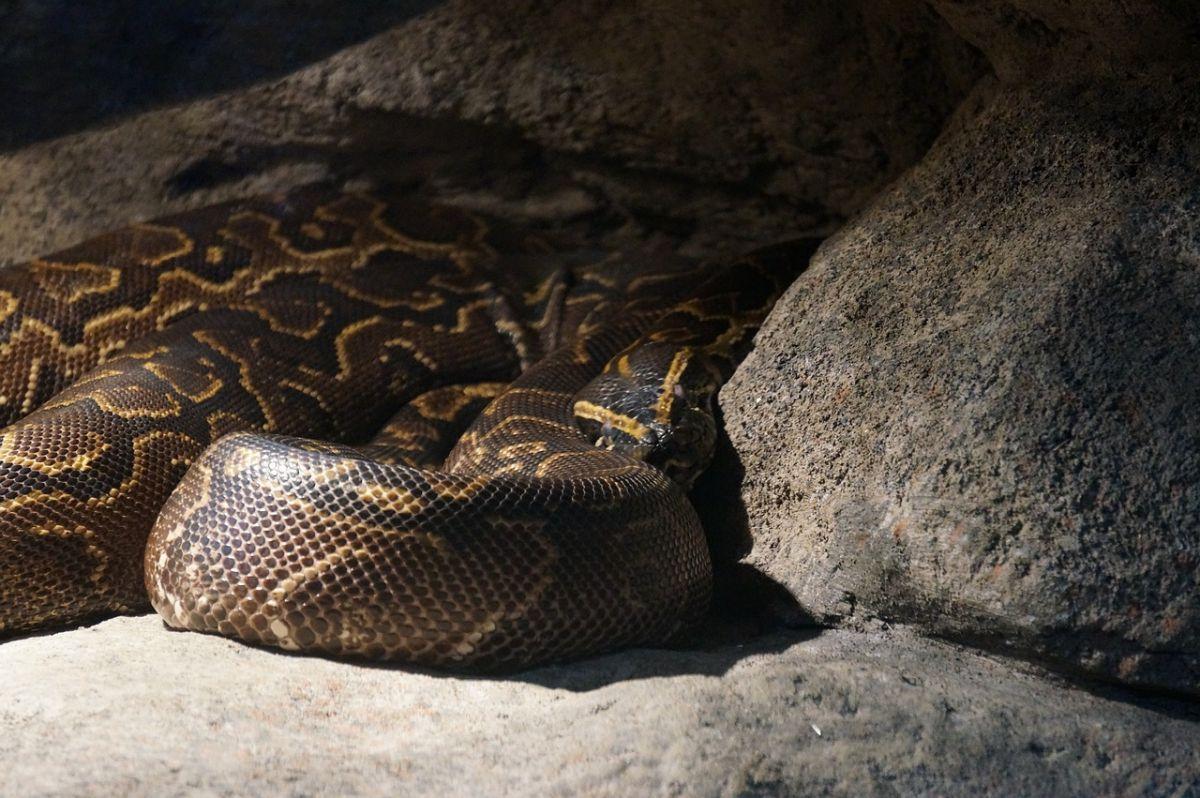
- Name: Burmese python
- Scientific name: Python bivittatus
- Conservation status:
Speaking of which, let us talk about all the Indian hog deer predators. The Burmese python is one of the largest species of snakes in the world, and the second heaviest of them. It is native to southwestern Asia and as far as the Indian subcontinent, and was introduced to Florida as part of the pet trade, where it is considered an invasive species.
Similarly to all other snakes, it is carnivorous and mostly feeds on mammals and birds, but can also adapt and eat reptiles and amphibians.
12. Dhole
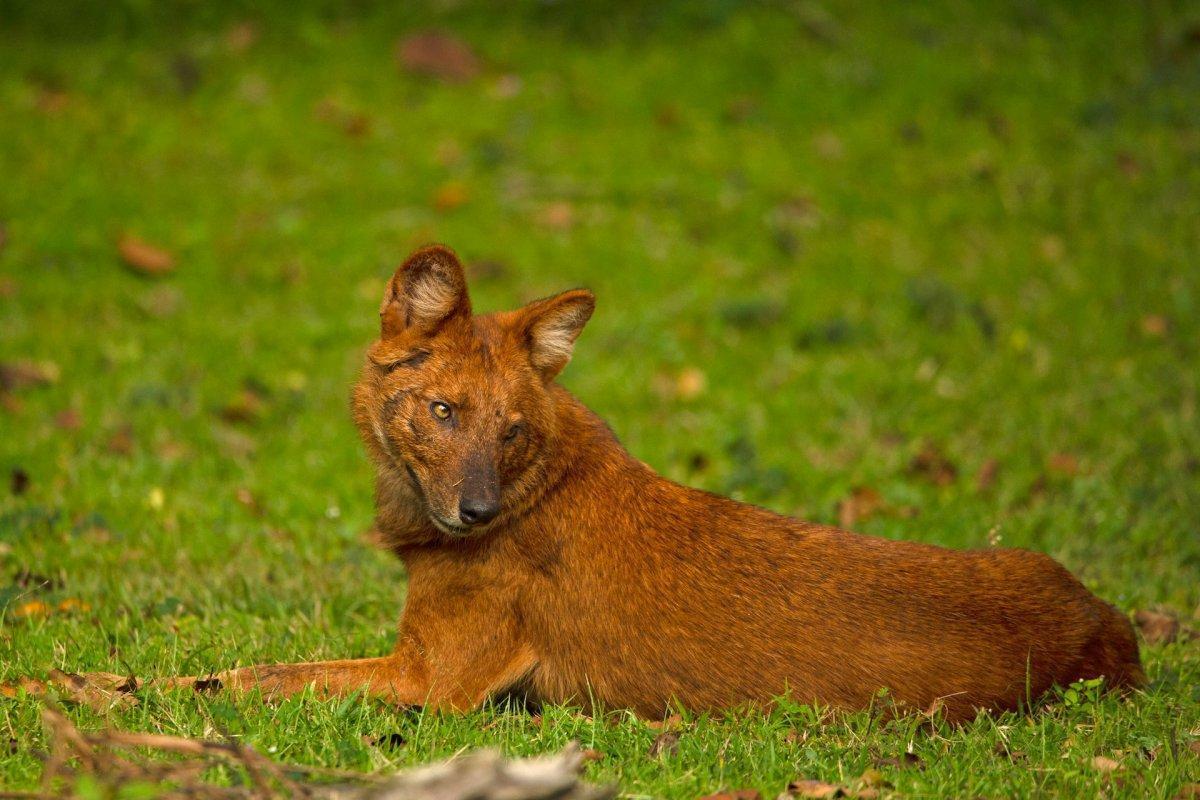
- Name: Dhole
- Scientific name: Cuon alpinus
- Conservation status:
The dhole, also known as the Indian wild dog, the red dog, the Asian wild dog, the mountain wolf, and the whistling dog, is a species of wild canid native to Central, South, East, and Southeast Asia. It is highly social and usually lives in large clans of up to 40 members, without a clear hierarchy.
It is a pack hunter that majorly hunts for medium to large ungulates, and it competes with the tiger and the leopard.
13. Indian leopard
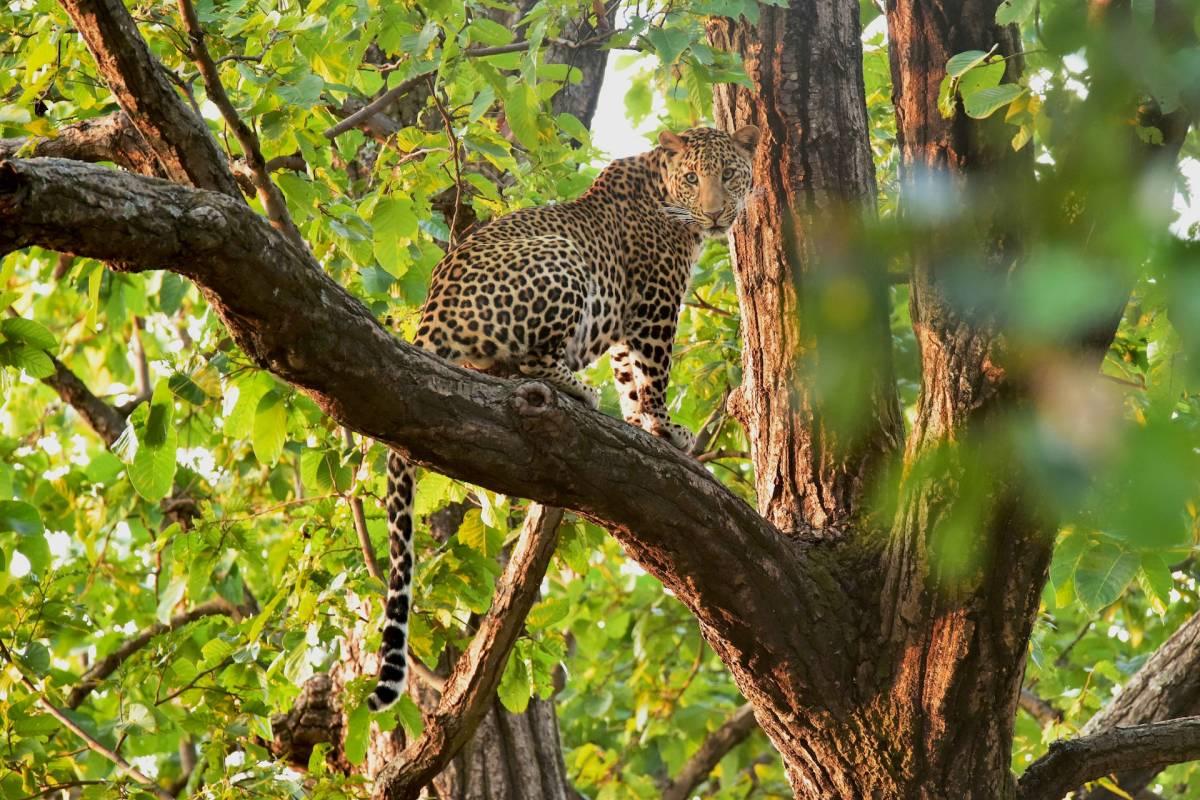
- Name: Indian leopard
- Scientific name: Panthera pardus fusca
- Conservation status:
The Indian leopard is a subspecies of the leopard, widely distributed on the Indian subcontinent. Similarly to other leopards, it is seriously threatened by poaching, persecution in conflict situations, and habitat loss, and is listed as vulnerable.
There are probably about 12,000 to 14,000 individuals left in India, but these numbers are very hard to assess since the Indian leopard is particularly solitary, nocturnal, and elusive.
14. Clouded leopard
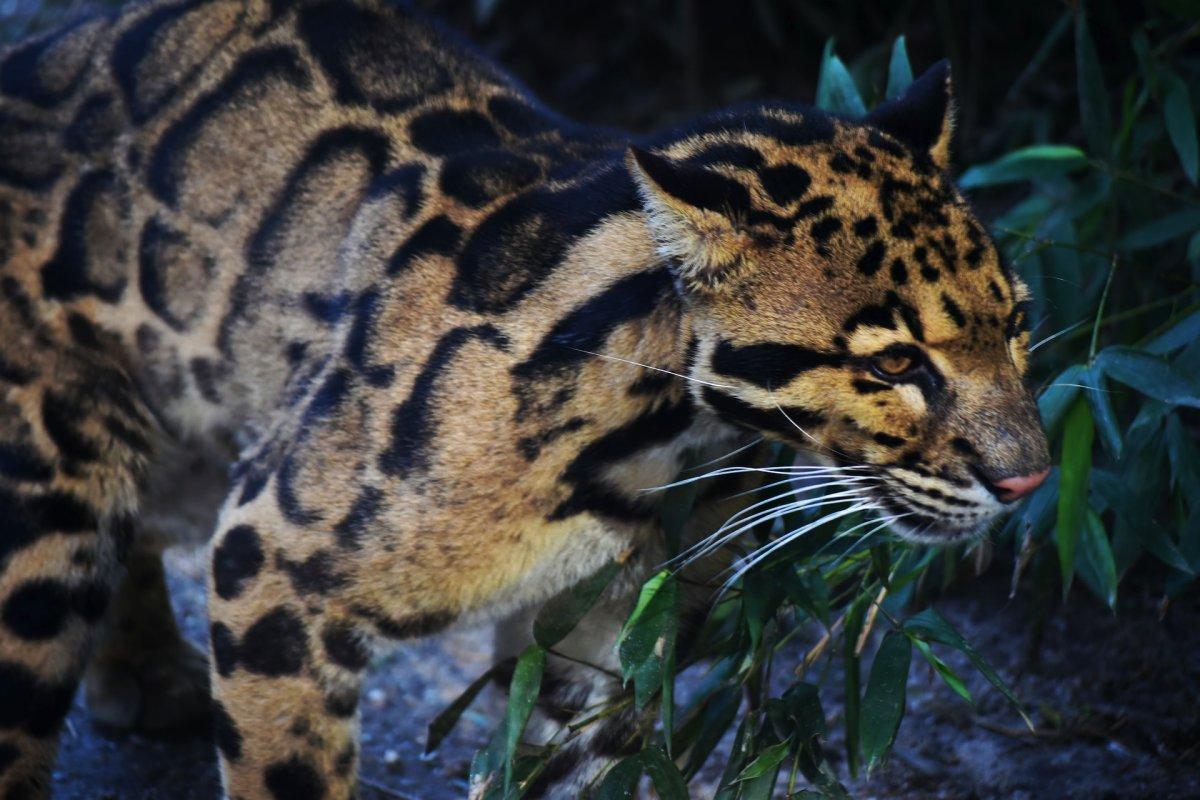
- Name: Clouded leopard
- Scientific name: Neofelis nebulosa
- Conservation status:
The clouded leopard, also known as the mainland clouded leopard, is a species of wild cat native to the Himalayas, southern China, and southeastern Asia. It lives in dense forests and has characteristic large dusky blotches all over its body, which is where it gets its name from.
Like many other large animals in India, the clouded leopard is considered vulnerable to extinction, as fewer than 10,000 mature individuals remain, and they are all still threatened by deforestation and poaching for its body parts.
15. Zebu
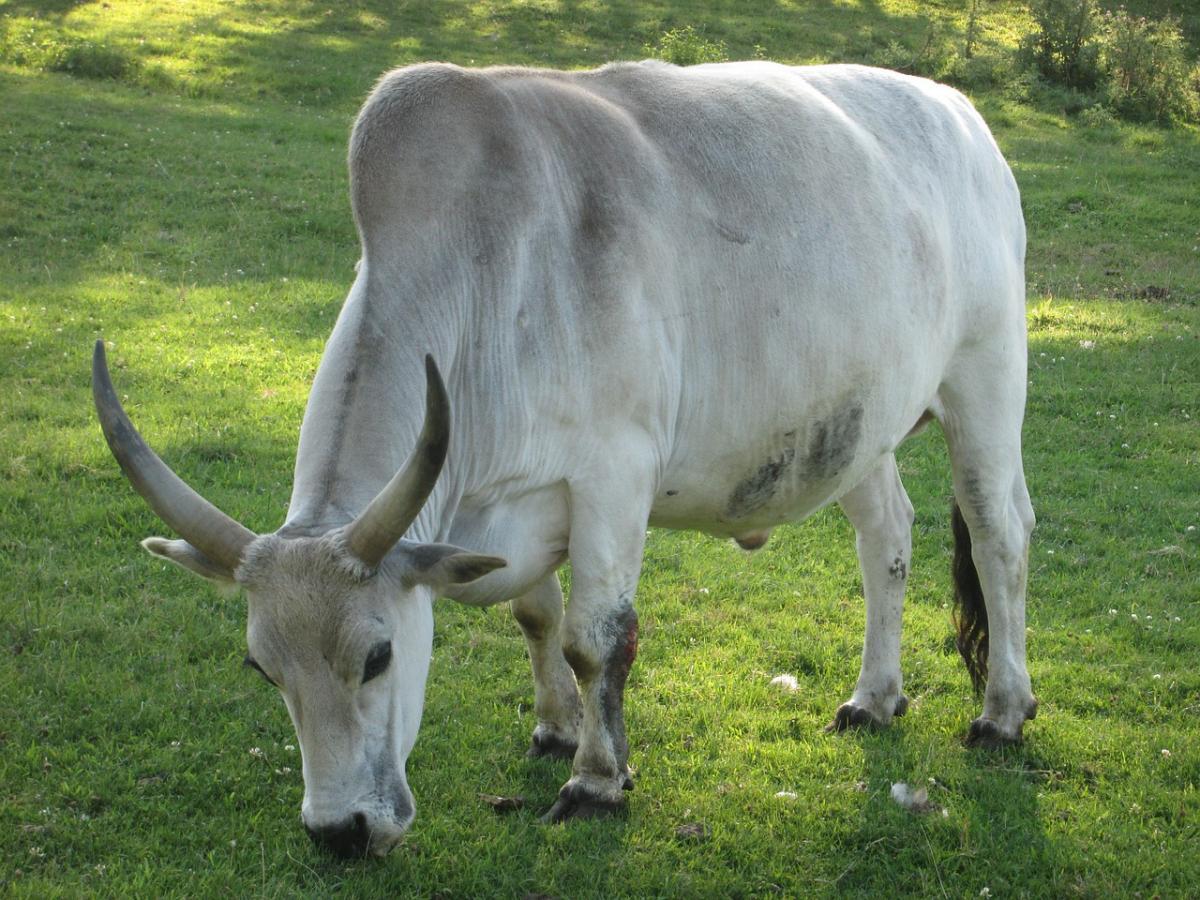
- Name: Zebu
- Scientific name: Bos indicus
- Conservation status:
The zebu, a widely domesticated animal also known as the humped cattle or the indicine cattle, is a species of domestic cattle native to the Indian subcontinent. As its common name suggests, it has a large, fatty hump on its shoulders, and it is well adapted to surviving in high temperatures habitats.
In India, this species is particularly important, as it has a prime role in religion.
16. Great hornbill
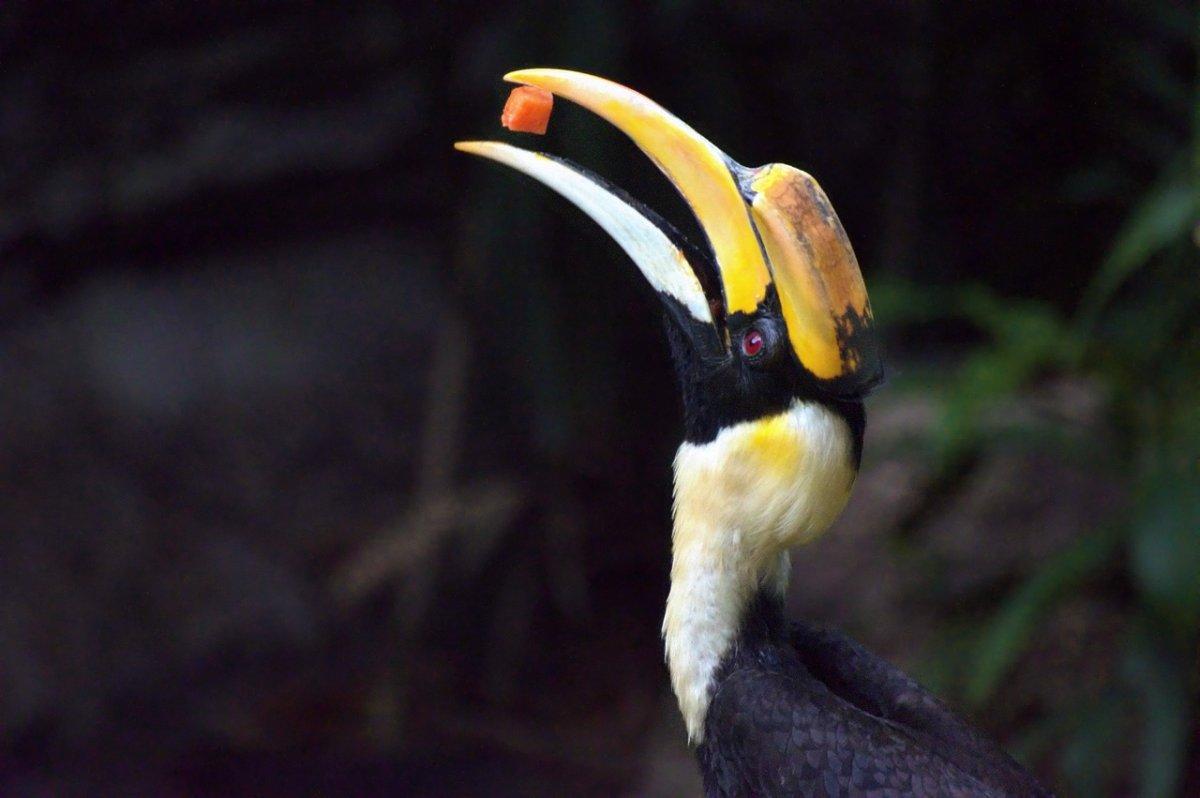
- Name: Great hornbill
- Scientific name: Buceros bicornis
- Conservation status:
The great hornbill, also known as the great Indian hornbill, the great pied hornbill, or the concave-casqued hornbill is a peculiar, spectacular bird. As its name implies, it has what looks like a horn on top of its bill, and it is impressively large and colorful. Because of this, it is important in many local cultures and rituals.
Interestingly enough, this majestic bird can live up to 50 years in captivity, and it is locally known as the “king of the jungle”.
17. Indian muntjac
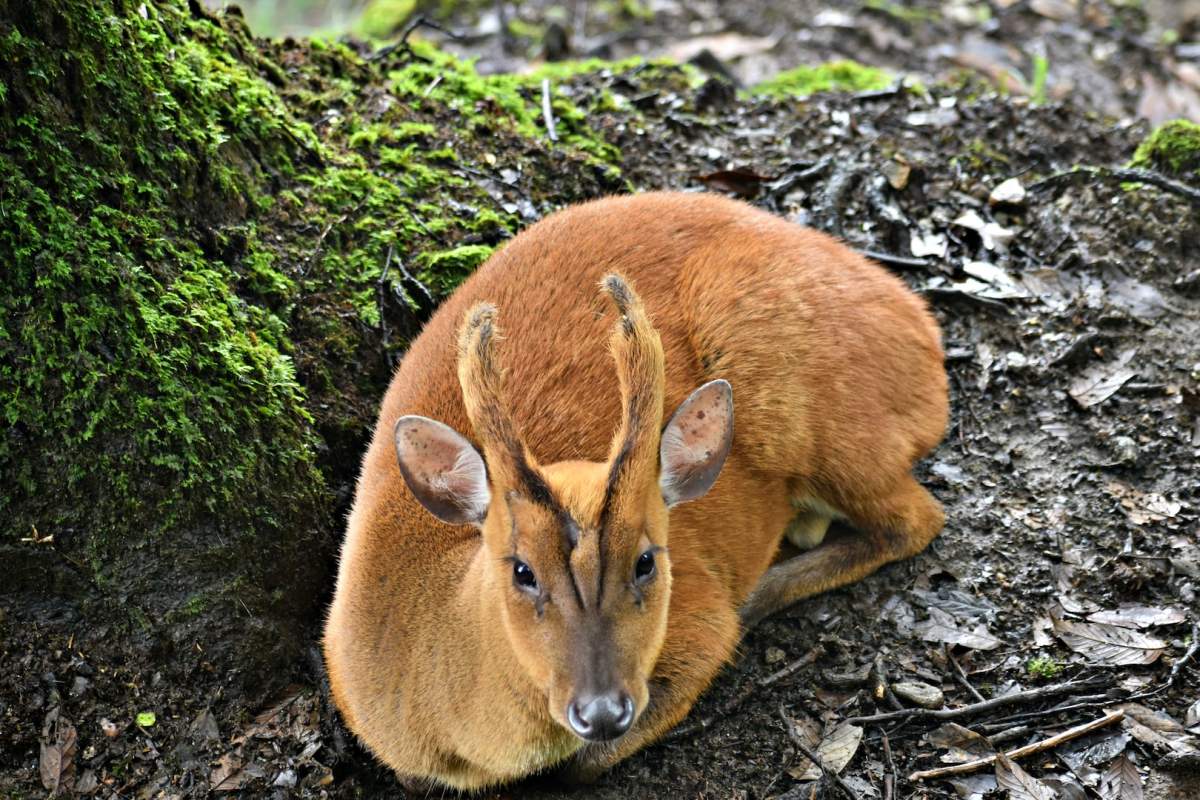
- Name: Indian muntjac
- Scientific name: Muntiacus muntjak
- Conservation status:
The Indian muntjac, also known as the barking deer or the southern red muntjac, is a species of deer native to southern and southeastern Asia. It has soft, short hair with creamy markings, but most importantly short, unique-looking antlers on top of its head.
It is one of the smallest species of deer, and it is omnivorous, feeding on grass, fruit, and seeds, but also bird eggs, small animals, and even carrion. It gets its common name from its call that sounds like barking!
18. Indian rhinoceros
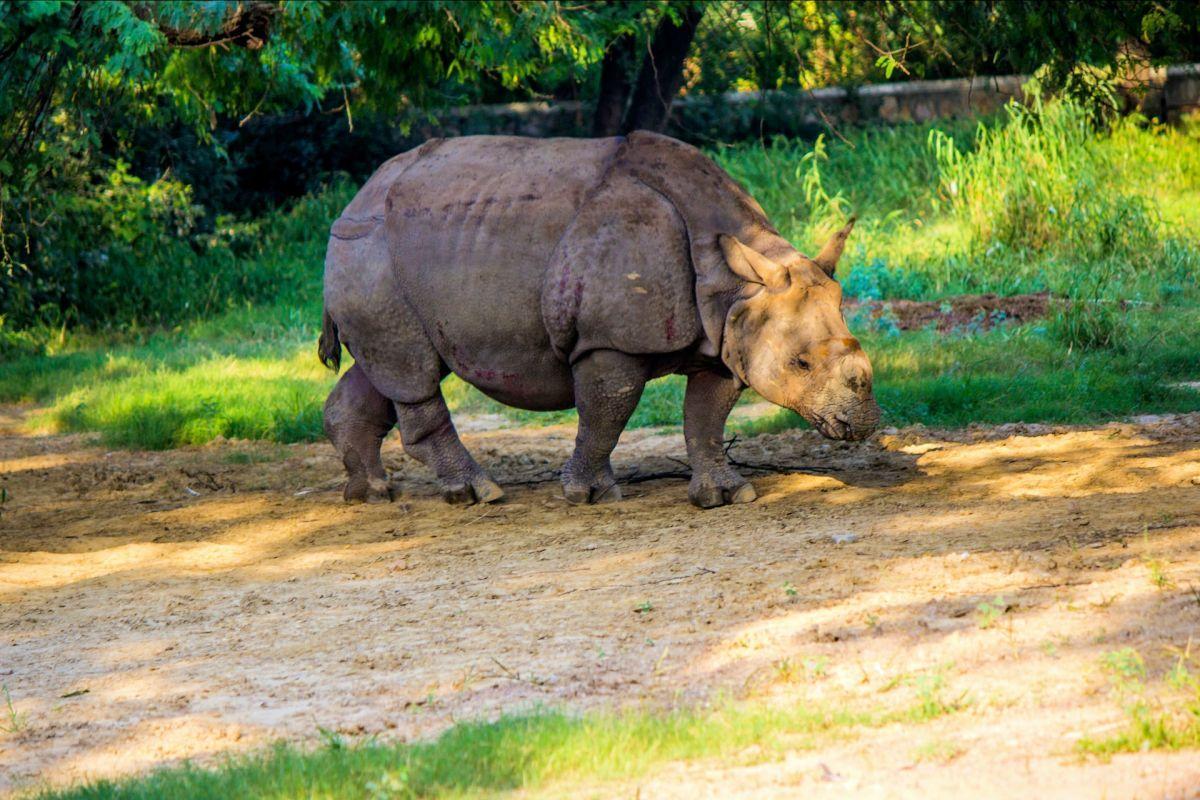
- Name: Indian rhinoceros
- Scientific name: Rhinoceros unicornis
- Conservation status:
The Indian rhinoceros, also known as the great Indian rhinoceros, the Indian rhino, or the greater one-horned rhinoceros, is a species of rhino native to the Indian subcontinent. Its populations are scattered and restricted to small ranges, which is why it is considered vulnerable. On top of this, its main habitats, grasslands, riverine forests, and savannas, are being destroyed by human and livestock expansion.
Most of the Indian rhino population is within India, but several hundred individuals can also be found in Nepal.
19. Sun bear
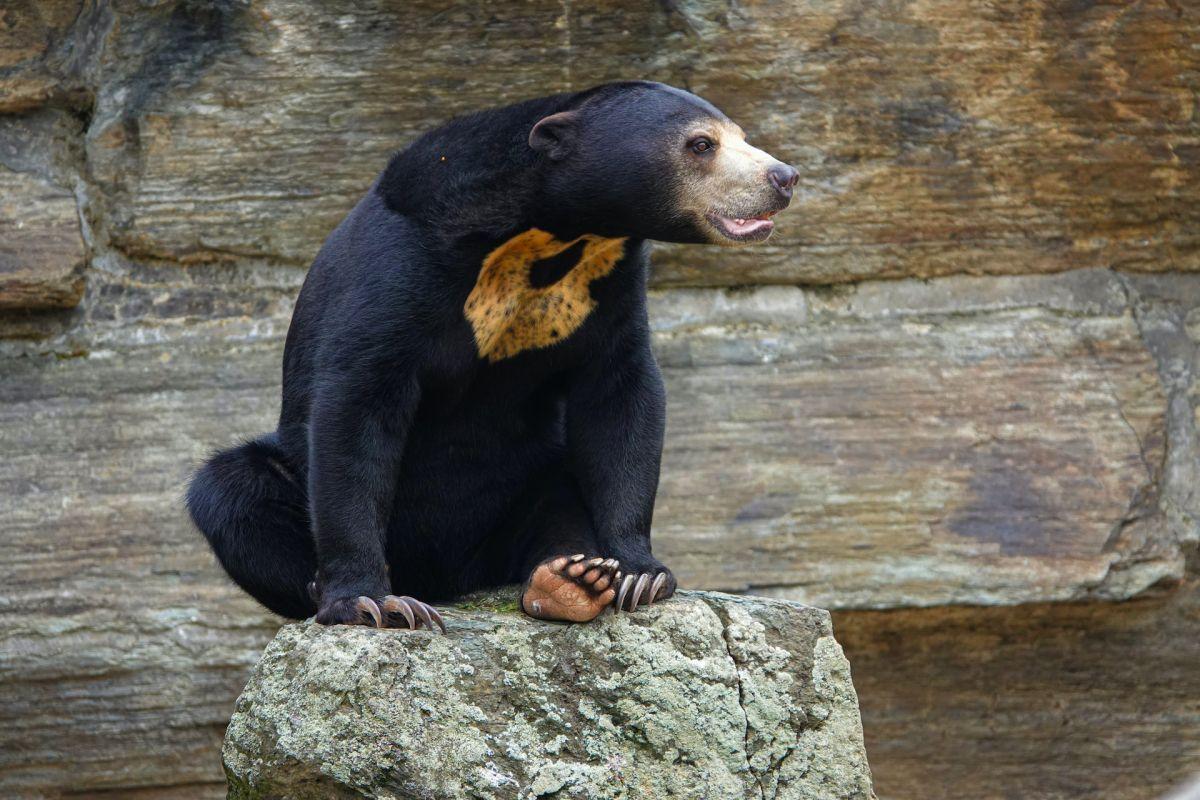
- Name: Sun bear
- Scientific name: Helarctos malayanus
- Conservation status:
The sun bear is a species of bear native to the tropical forests of Southeast Asia. It is the smallest of all bears, but is stockily built and has large paws.
Interestingly, this bear is the most arboreal of all, and it is an excellent climber that sleeps in trees, several meters above the ground. If humans are present within its territory, it will be active by night, but outside of that, it is a diurnal omnivore that feeds on ants, honey, termites, vertebrates, and plant material.
20. Asiatic lion
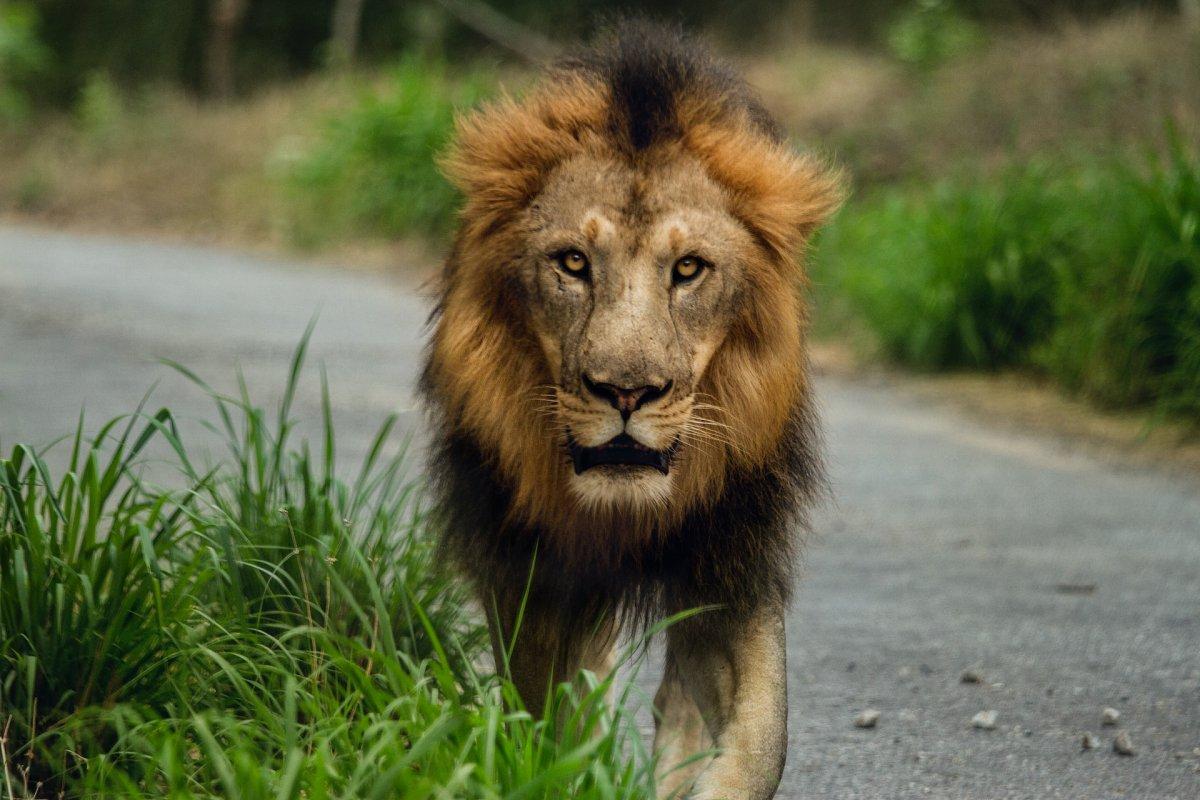
- Name: Asiatic lion
- Scientific name: Panthera leo leo
- Conservation status:
The Asiatic lion is a population of northern lions only surviving in India. While it has a very important cultural impact, such as being part of Hindu mythology, religion, and folklore, it is seriously threatened by habitat loss and poaching.
Male Asiatic lions are either solitary animals or gather in all-male groups. They rest, hunt, and feed together and mark the same sites. On the other hand, females live with up to 12 other females alongside their cubs.
21. Indian elephant
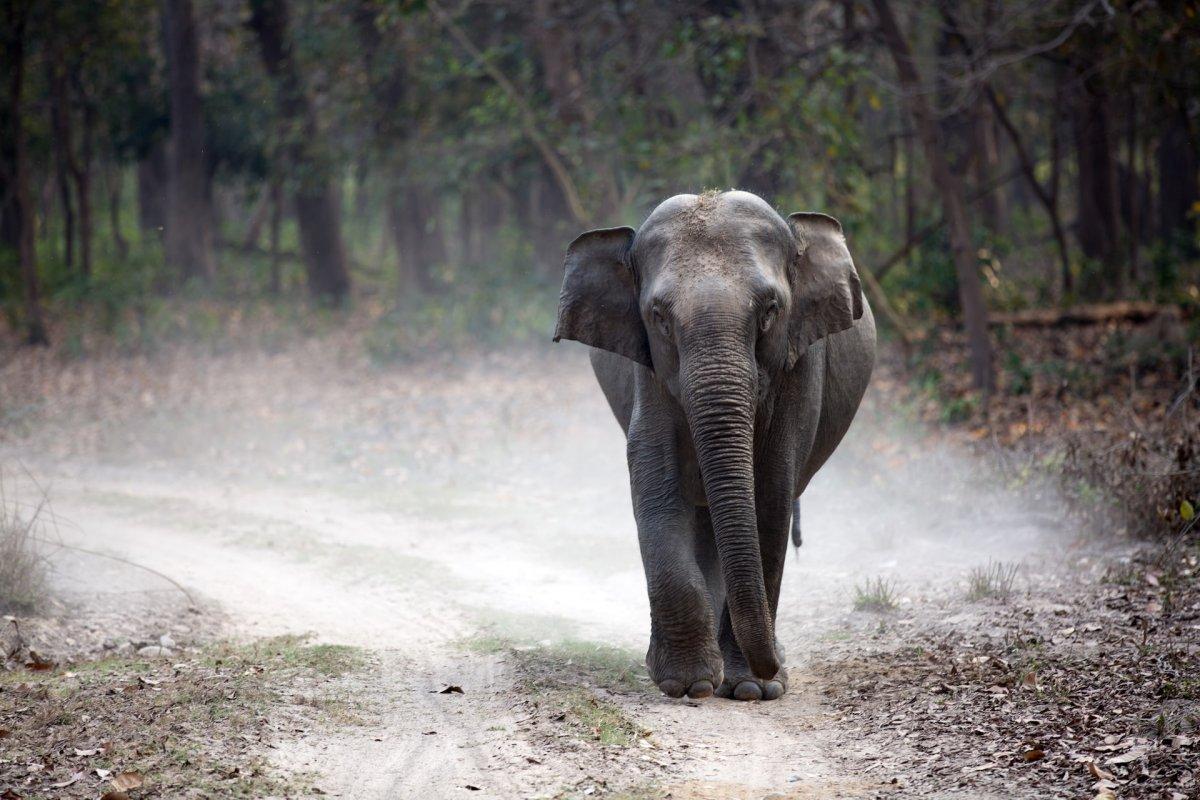
- Name: Indian elephant
- Scientific name: Elephas maximus indicus
- Conservation status:
The Indian elephant is one of three subspecies of the Asian elephant, and it is native to mainland Asia. Its population has drastically declined by more than half since the 1930s, which is equivalent to three elephant generations. It is threatened by habitat fragmentation, degradation, and loss.
This elephant is a megaherbivore that feeds on up to 150 kg / 330 lb of plant matter per day! It eats more than a hundred different plant species, with the portion varying with the season.
22. Markhor
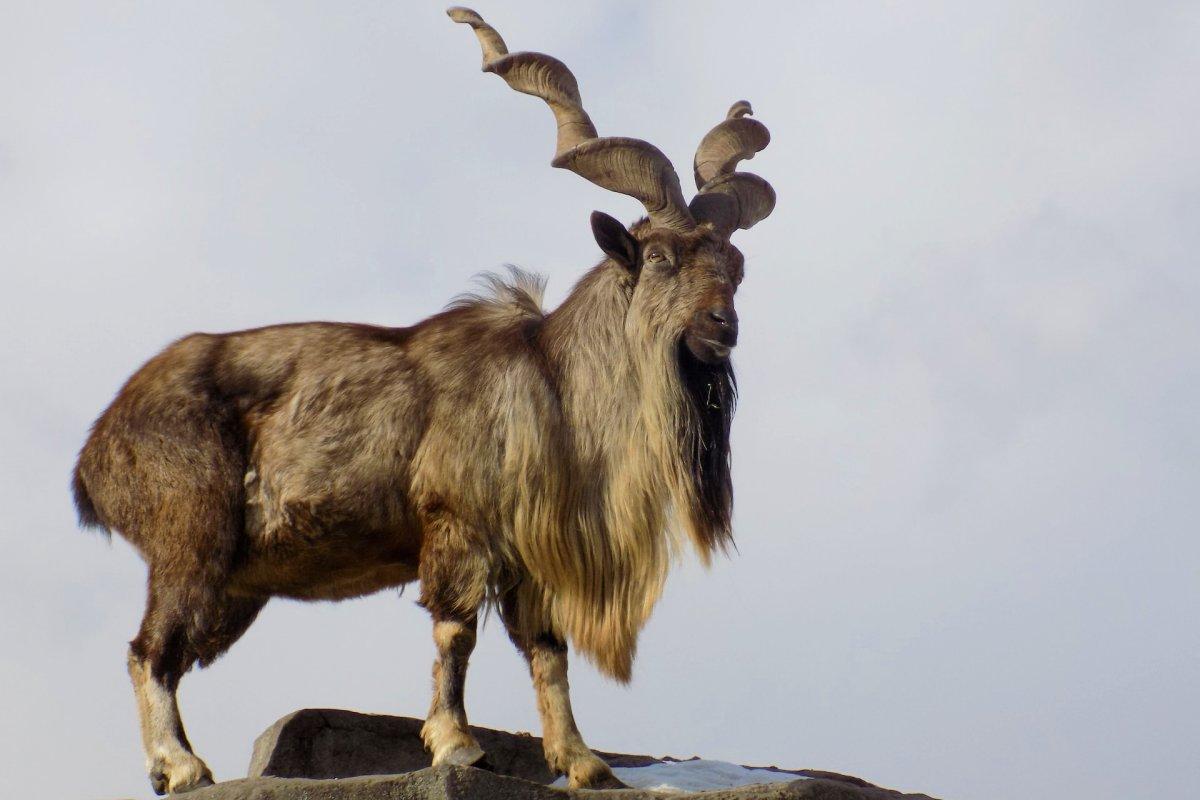
- Name: Markhor
- Scientific name: Capra falconeri
- Conservation status:
The markhor, also known as the screw horn, is a large species of wild goat native to Central Asia, the Himalayas, and the Karakoram. It is the national animal of Pakistan and, as its name implies, has long, corkscrew-like horns.
This goat is particularly adapted to mountainous terrain and lives at altitudes between 600 and 3,600 m / 2,000 and 11,800 ft. It is diurnal and most active in the early morning and late afternoon.
23. Mugger crocodile
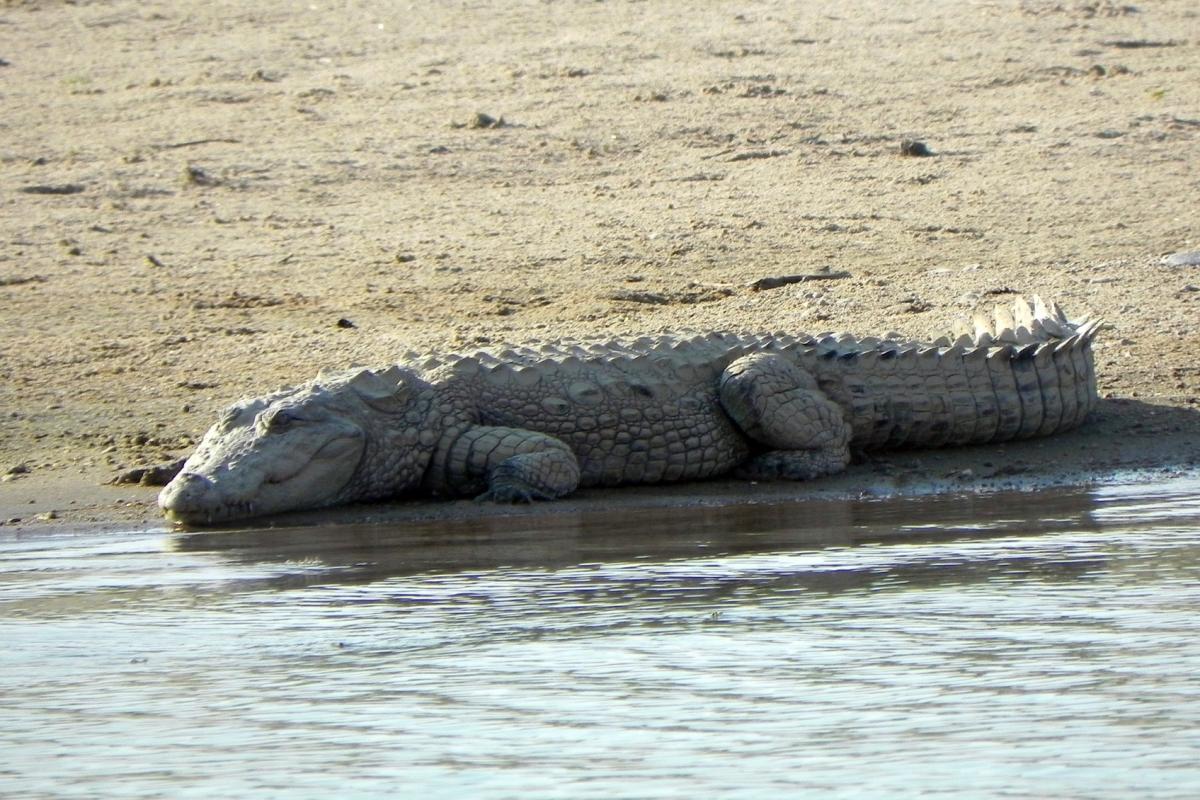
- Name: Mugger crocodile
- Scientific name: Crocodylus palustris
- Conservation status:
The mugger crocodile, also known as the marsh crocodile or simply the mugger, is a species of crocodilian native to the Indian subcontinent and Iran. It inhabits marshes, artificial ponds, rivers, and lakes.
This crocodile is a powerful swimmer that sometimes walks on land while looking for bodies of water during the hot season. It digs holes in the sand and lays up to 46 eggs in the dry season, and it has long been a symbol of destructive powers.
24. Nilgiri marten
- Name: Nilgiri marten
- Scientific name: Martes gwatkinsii
- Conservation status:
The Nilgiri marten is the only species of marten native to southern India. It gets its name from the center of its range, the Nilgiri Hills, and only about a thousand individuals are left in the wild, which is why it is considered vulnerable.
This mammal is a diurnal animal that is mostly arboreal but occasionally descends on the ground. It is omnivorous and preys on birds, insects, and small mammals.
25. Bamboo pit viper
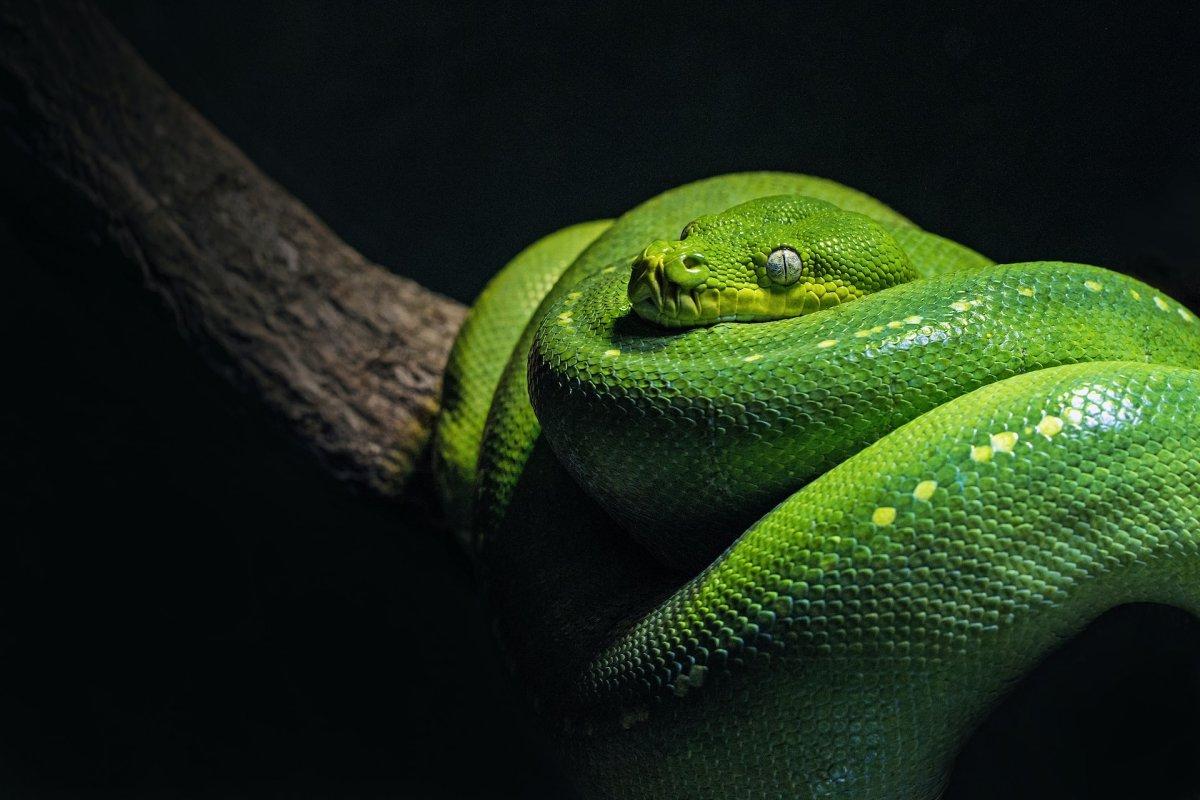
- Name: Bamboo pit viper
- Scientific name: Craspedocephalus gramineus
- Conservation status:
The bamboo pit viper, also known as the Indian green pit viper or the common green pit viper, is a species of venomous pit viper native to southern and northeastern parts of India.
It is a very bright green species of snake, with yellow underparts, that is found in bamboo groves and forests, hence its name. Nocturnal and arboreal, it is aggressive and does not hesitate to bite when threatened; its venom is quite dangerous.
26. Ganges river dolphin
- Name: Ganges river dolphin
- Scientific name: Platanista gangetica
- Conservation status:
The Ganges river dolphin, locally known as the shushuk or the susu, is a species of toothed whale native to the Ganges river of India. It can also be found in other southern Asian rivers, in Bangladesh and Nepal, and it is the national aquatic animal of India.
This dolphin usually lives in pairs or alone, and it does not do acrobatic displays. Because of its shyness around boats, it is hard to observe, and not much more is known about its behavior.
27. Sri Lankan green vine snake
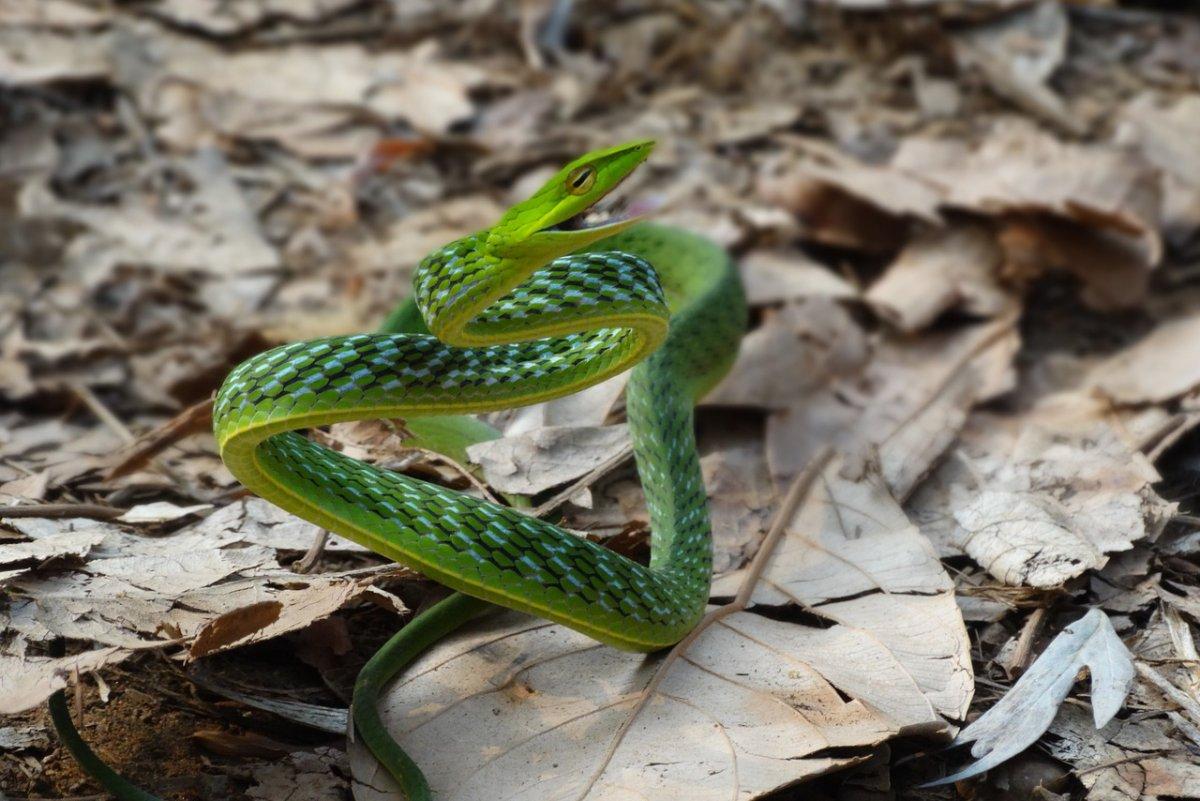
- Name: Sri Lankan green vine snake
- Scientific name: Ahaetulla nasuta
- Conservation status:
The Sri Lankan green vine snake, also known as the long-nosed whip snake, is a species of venomous tree snake endemic to Sri Lanka and parts of India.
It is arboreal, mildly venomous, and diurnal, and feeds on lizards and frogs. In order to find its prey, it uses its binocular vision, and relies on camouflage, looking just like vines. Its venom causes swelling, bruising, and pain for about 3 days, but is not severe unless close to the head, eyes, or other vital organs.
28. Ruddy shelduck
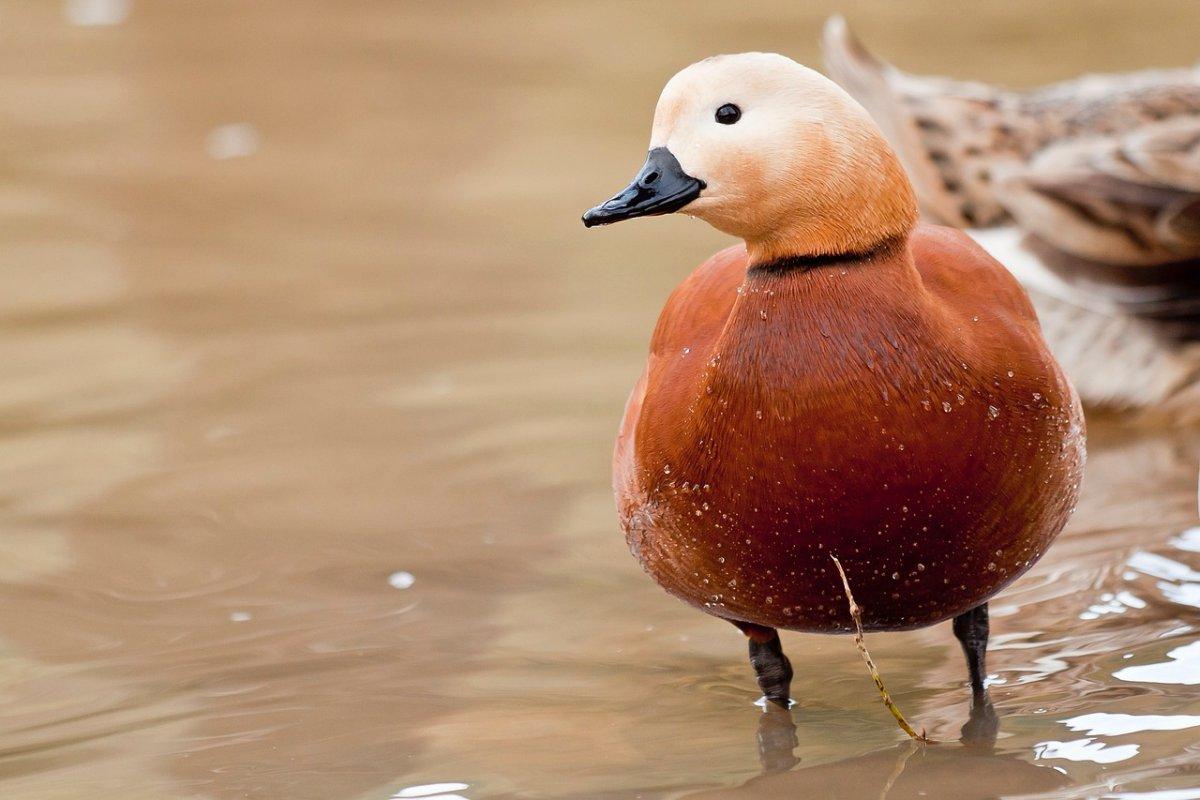
- Name: Ruddy shelduck
- Scientific name: Tadorna ferruginea
- Conservation status:
The ruddy shelduck, also known as the Brahminy duck, is a species of waterfowl native to Europe and the Indian subcontinent: it usually winters in India, and breeds in southeastern Europe and Central Asia. Its call is surprisingly loud.
This shelduck lives in inland bodies of water such as reservoirs, lakes, and rivers, and forms a lasting pair bond with a member of the opposite sex; their nest is placed in hidden crevices and holes, well away from water.
29. Caracal
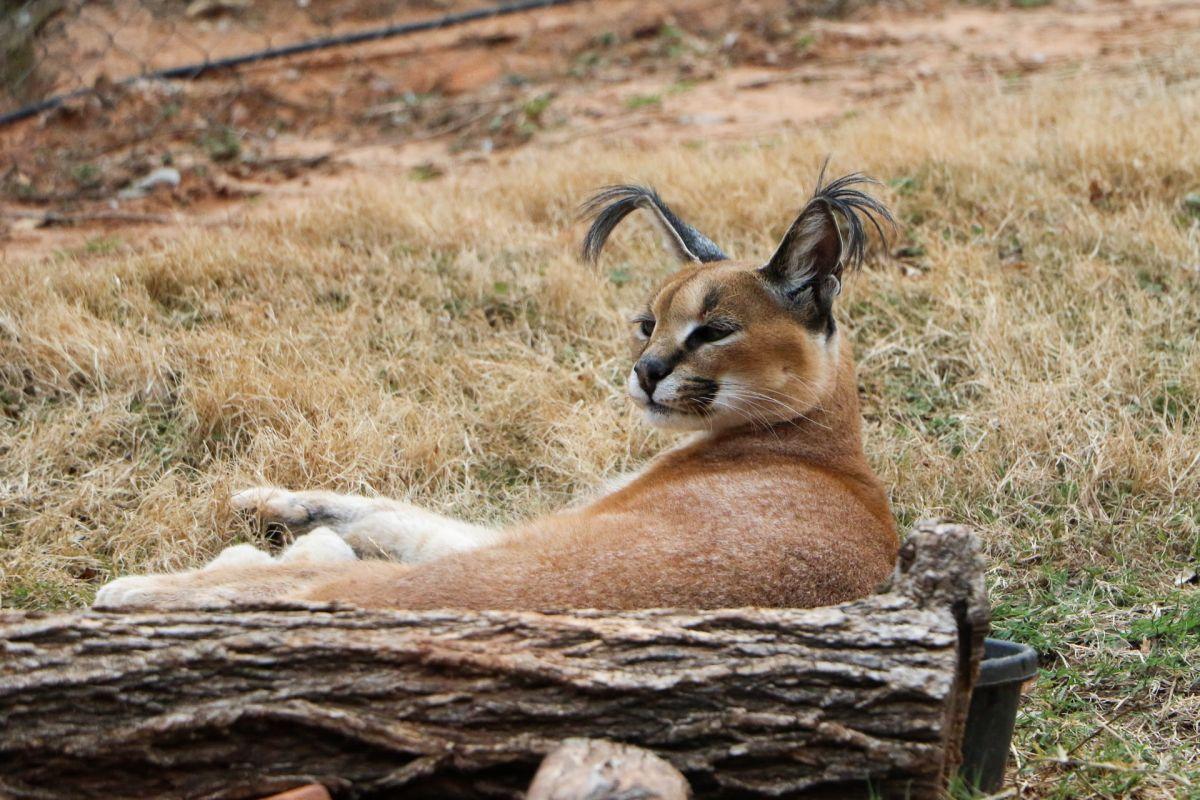
- Name: Caracal
- Scientific name: Caracal caracal
- Conservation status:
The caracal is a medium-sized species of wild cat native to Central Asia, Pakistan, India, Africa, and the Middle East. It has long legs and long, tufted ears, as well as long canine teeth.
This nocturnal animal has a red coat and usually preys on small mammals, rodents, and birds. Besides, it is very agile and can leap higher than 3 m / 10 ft and catch birds in midair!
30. Chital
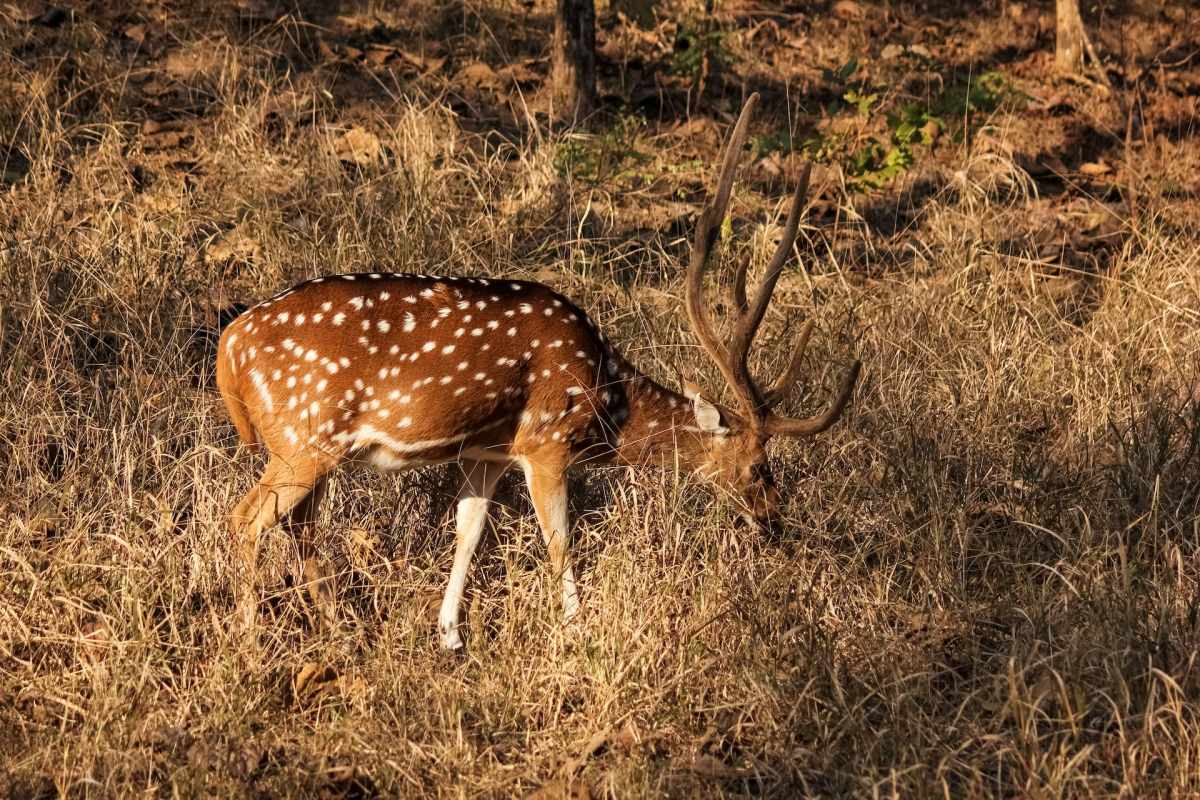
- Name: Chital
- Scientific name: Axis axis
- Conservation status:
The chital, also known as the spotted deer, the axis deer, or the chital deer, is a species of deer native to the Indian subcontinent. Medium-sized, it has white spots all over its body, and only males wear large antlers.
This deer can be found in India, Nepal, Bangladesh, Sri Lanka, and Bhutan, and has also been introduced in countries such as the United States and Australia.
31. Wild yak
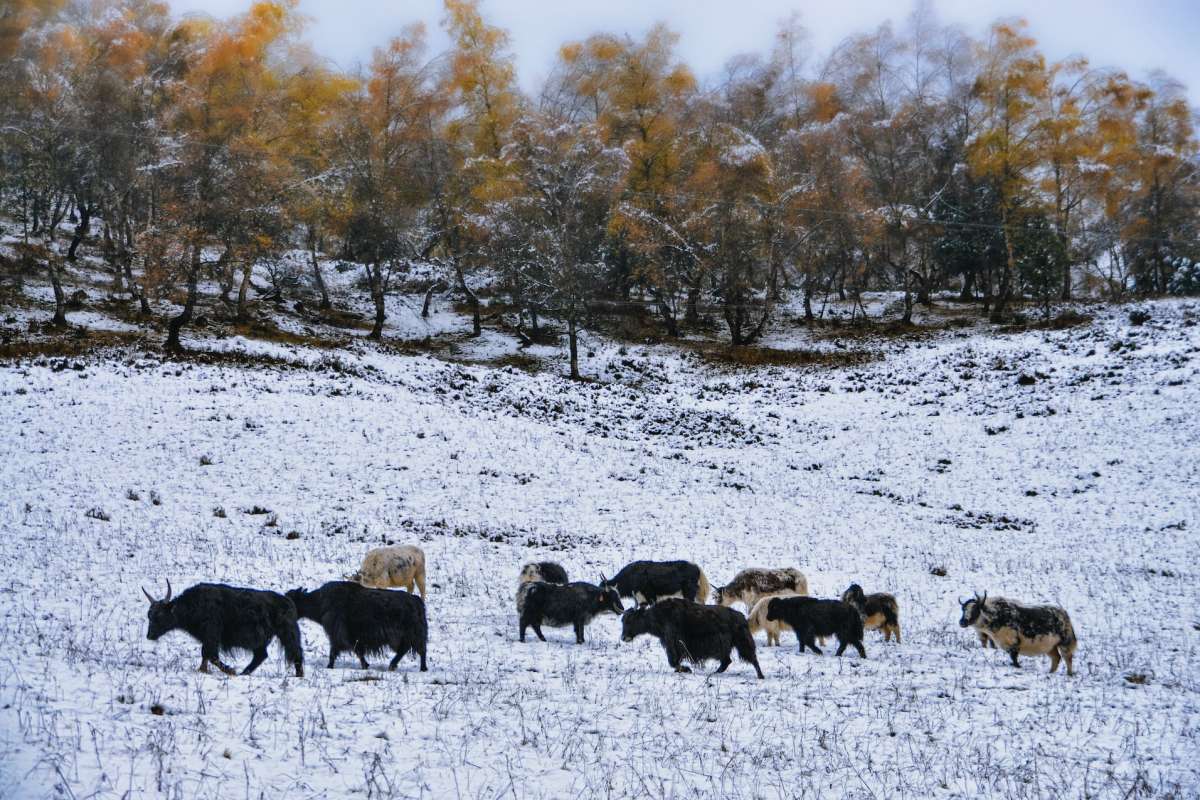
- Name: Wild yak
- Scientific name: Bos mutus
- Conservation status:
The wild cat is a large species of wild cattle native to the Himalayas, and one of the most closely related animals to indigenous peoples of the heights of the mountains. It is the living ancestor of the domestic yak, and is one of the largest bovid species in the world, standing at up to 2.05 m / 6.7 ft tall at the shoulder!
This animal has a bulky frame and characteristic long hairs hanging from its underparts.
32. Painted stork
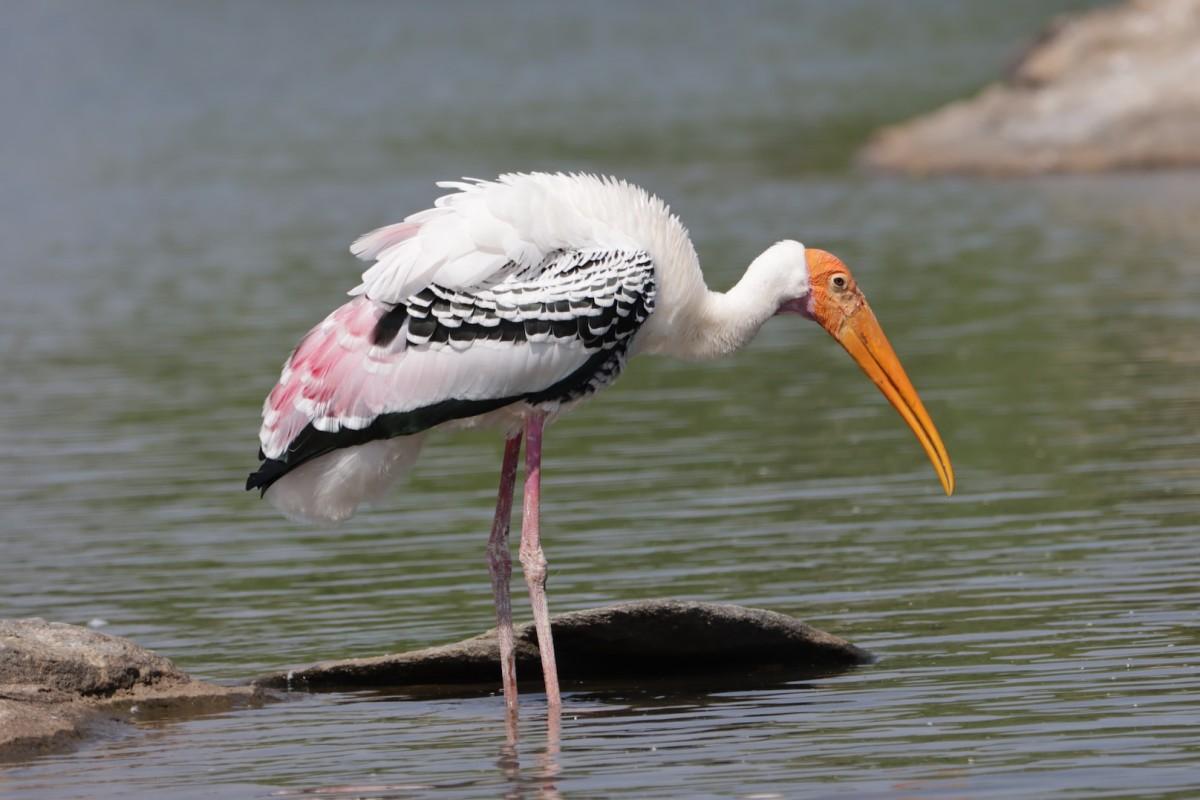
- Name: Painted stork
- Scientific name: Mycteria leucocephala
- Conservation status:
The painted stork is a large species of wader native to southern and southeastern Asia. It inhabits the wetlands and the tropical areas of the continent and has a particularly colored head and bill.
This stork lives in flocks around shallow waters. It immerses its half-open beak and snaps up its prey, mostly fish, frogs, and snakes. It is becoming a more and more popular tourist attraction due to its large size and color, which is one of the many threats this animal is currently facing.
33. Common krait
- Name: Common krait
- Scientific name: Bungarus caeruleus
- Conservation status:
The common krait, also known as the blue krait, is a species of highly venomous snake native to the Indian subcontinent. It is one of the Big Four species that inflict the most snakebites in India and Pakistan, and its venom, if untreated, can kill an adult human in 4 to 5 hours because of respiratory paralysis. The biggest danger with this snake is that the bite itself is not very painful which creates false reassurance to the victim.
Good thing though, as this snake is nocturnal and rarely encounters humans during the day.
34. Sangai
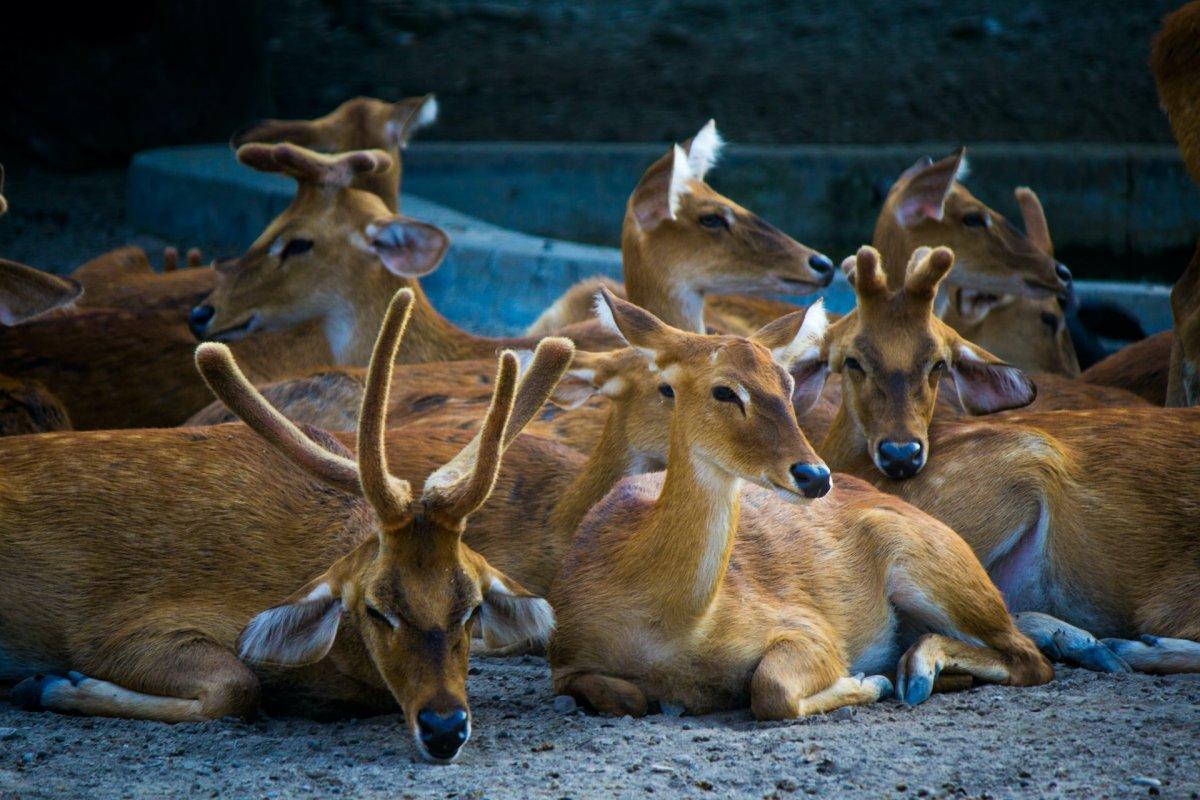
- Name: Sangai
- Scientific name: Rucervus eldii eldii
- Conservation status:
The sangai, also known as the dancing deer or the brow-antlered deer, is a species of Eld’s deer endemic to the state of Manipur in northeastern India. It lives in grasslands, around the Loktak Lake, the largest freshwater lake in eastern India, and particularly likes phumdi, a floating mass of vegetation.
When it comes to feeding, this deer’s diet is made of a variety of water plants, shoots, and grasses.
35. Indo-Pacific finless porpoise
- Name: Indo-Pacific finless porpoise
- Scientific name: Neophocaena phocaenoides
- Conservation status:
The Indo-Pacific finless porpoise is one of eight porpoise species, and it is native to most of the Indian Ocean. It lives in the coastal, shallow waters of Asia, mostly around India, Malaysia, Indonesia, and Bangladesh, and is generally about the same size as a human, although it can reach up to 2.27 m / 7 ft 5 in in length.
This porpoise has no dorsal fin, as its name suggests, and it is an opportunistic feeder that eats fish, cephalopods, and crustaceans, depending on availability.
36. Mishmi takin
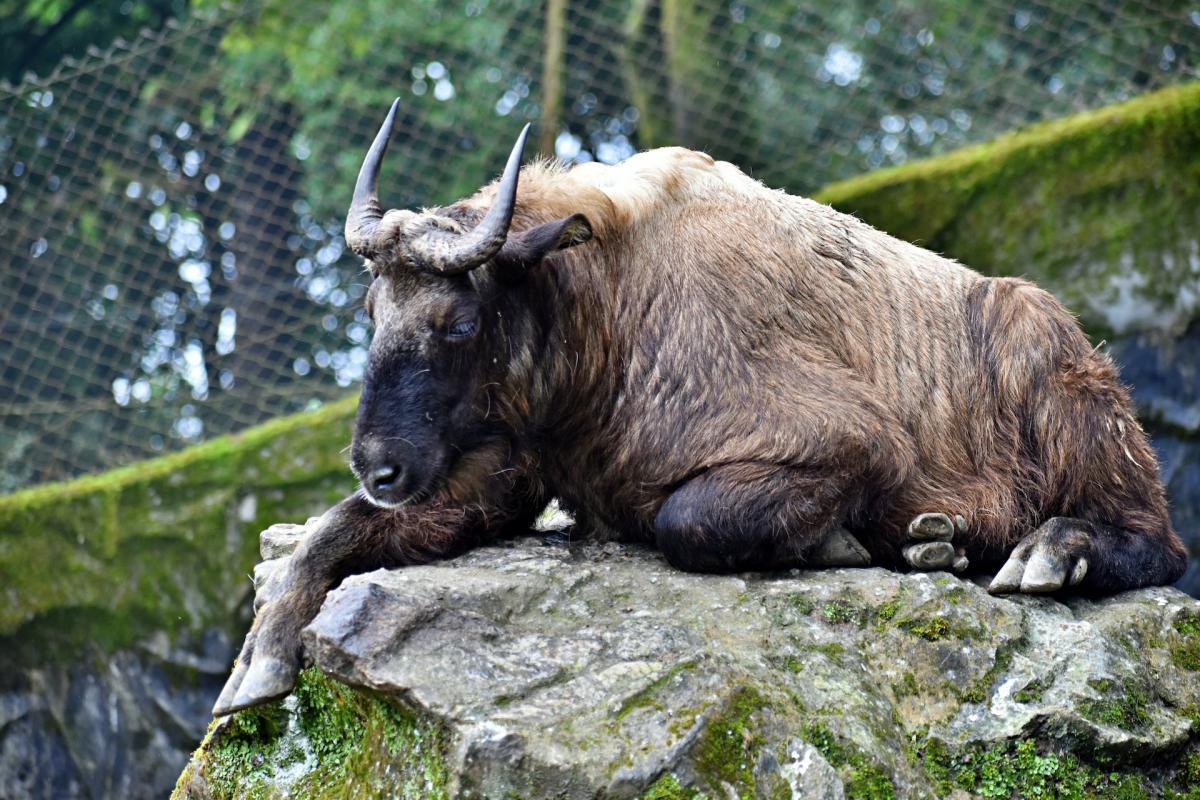
- Name: Mishmi takin
- Scientific name: Budorcas taxicolor taxicolor
- Conservation status:
The Mishmi takin is a subspecies of takin, a goat-antelope native to India, China, and Myanmar. It can be found in northeastern India, and it feeds on willow and bamboo shoots. Its oily coat is particularly efficient as protection from the fog.
The takin is a large ungulate that can be found between 1,000 m and 4,500 m / 3,300 and 14,800 ft above sea level and lives in groups of about 20 members.
37. Siberian ibex
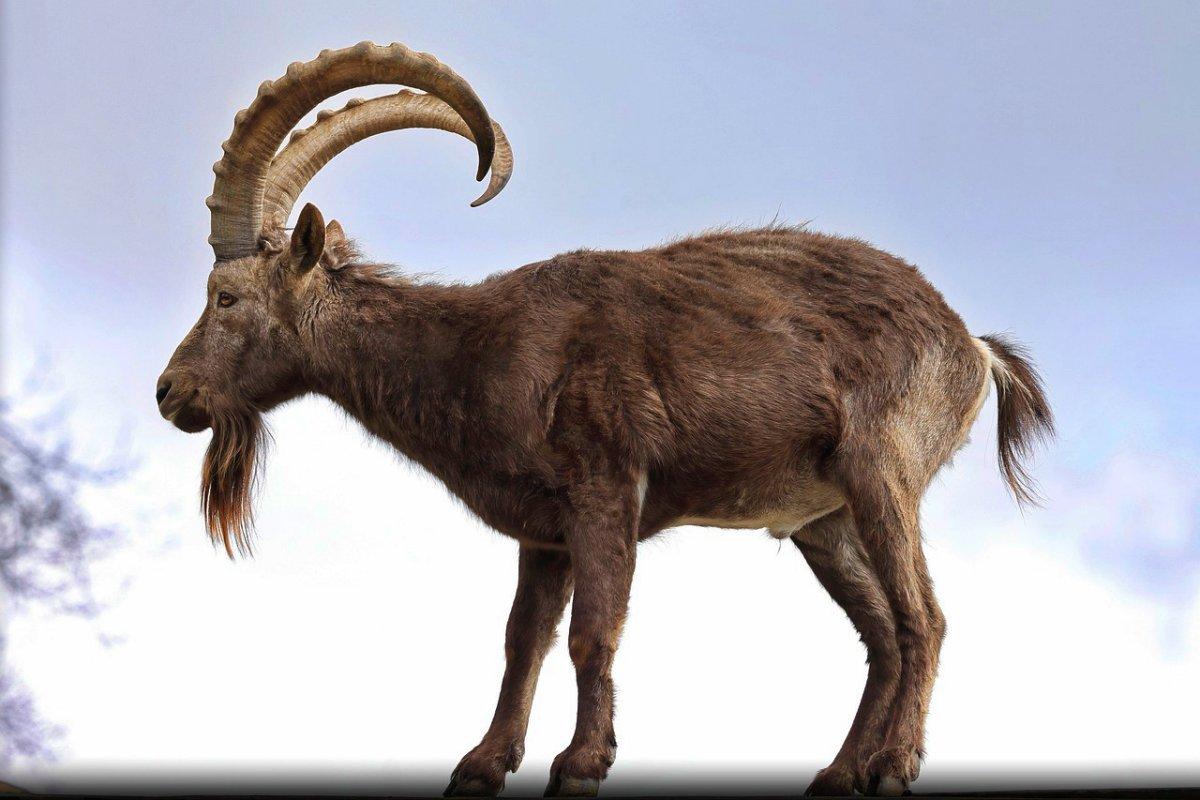
- Name: Siberian ibex
- Scientific name: Capra sibirica
- Conservation status:
The Siberian ibex, also known as the Gobi ibex, the Himalayan ibex, the Mongolian ibex, the Tian Shan ibex, the Central Asian ibex, or the Altai ibex, is a species of ibex, a wild goat, that lives in Central Asia.
It is not quite certain that it is a distinct species, as it could be conspecific with the Alpine ibex. This goat is the longest and heaviest member of the genus Capra, and it lives at high elevations, in large herds.
38. Saltwater crocodile
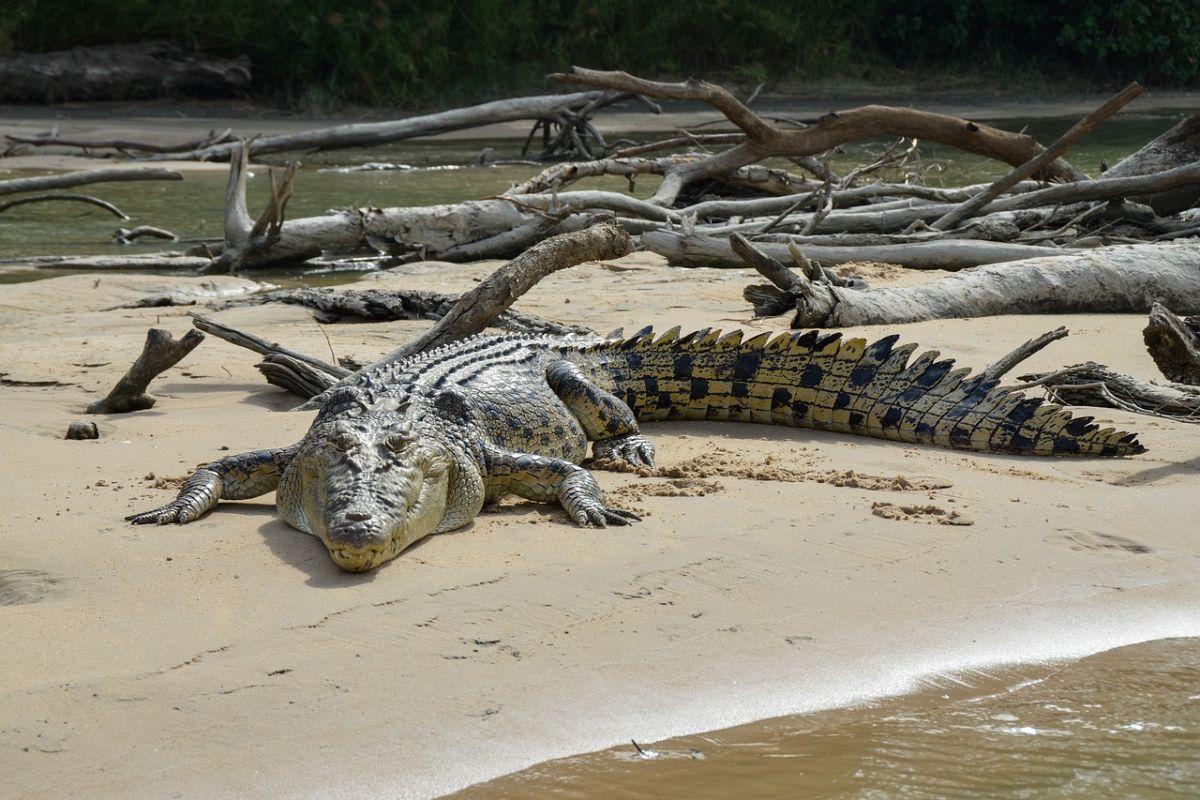
- Name: Saltwater crocodile
- Scientific name: Crocodylus porosus
- Conservation status:
The saltwater crocodile, also known as the Indo-Pacific crocodile, the estuarine crocodile, the sea crocodile, or the marine crocodile, is the largest living reptile and crocodilian in the world.
Reaching a length of up to 6.3 m / 21 ft and weighing up to 1,300 kg / 2,900 lb, it is an incredibly strong opponent that you should never encounter. In fact, it is one of two crocodile species (alongside the Nile crocodile) that considers humans as food, and it is an opportunistic hypercarnivorous apex predator that ambushes most of its prey before drowning it… or swallowing it entirely!
39. Northern hog badger
- Name: Northern hog badger
- Scientific name: Arctonyx albogularis
- Conservation status:
The northern hog badger is a species of mustelid native to eastern and southern Asia. It is much smaller than its close relative the greater hog badger, and it has a softer pelage with longer hairs.
During the winter months, its underfur becomes particularly thick, and it can be found from northeastern India to Bangladesh and China. Unconfirmed reports claim that it also lives in Bhutan and Nepal.
40. Red panda
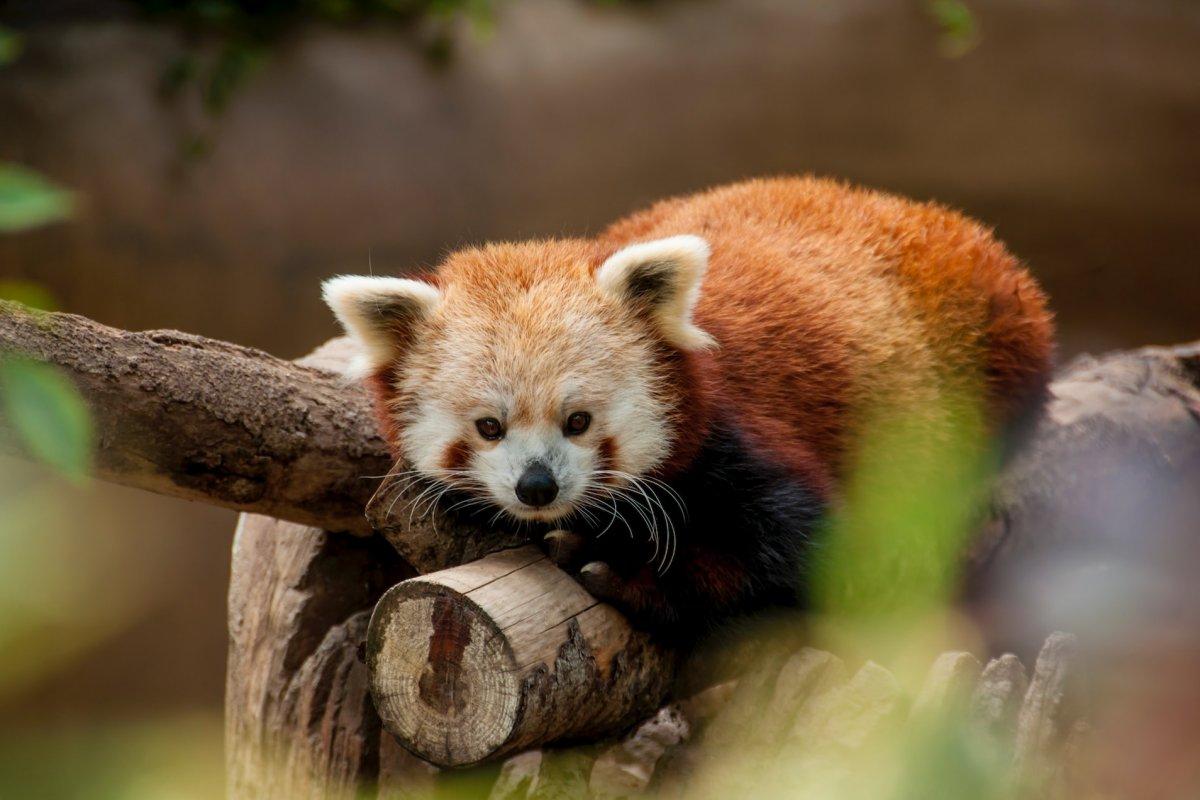
- Name: Red panda
- Scientific name: Ailurus fulgens
- Conservation status:
The red panda, also known as the lesser panda, is one of the most famous animals from the Asian continent. It has dense, reddish-brown fur and is native to southwestern China and the Himalayas.
This mammal lives in coniferous forests, where it is solitary and mostly arboreal. It feeds on bamboo leaves and shoots, but also blossoms and fruits. It currently faces serious threats such as poaching and habitat loss due to deforestation, and conservation programs were launched in hopes to save this cute little panda.
41. Indian boar
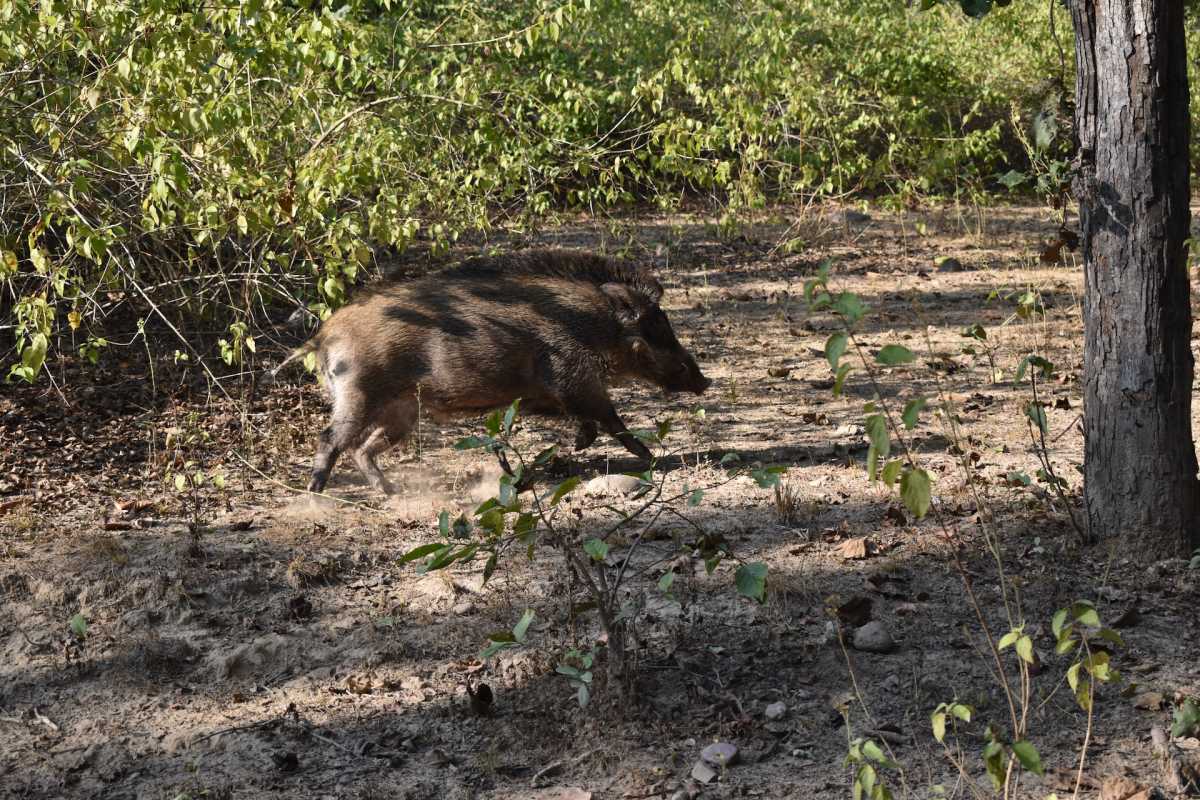
- Name: Indian boar
- Scientific name: Sus scrofa cristatus
- Conservation status:
The Indian boar, also known as the Moupin pig or the Andamanese pig, is a subspecies of the wild boar native to India, Thailand, Sri Lanka, Nepal, and Myanmar.
No matter on which continent you go, there will always be a species of wild boar, and this one has a large, characteristic mane that runs in a crest along its back. It has been interacting with humans for thousands of years and is an important part of local culture and stories.
42. Indian golden gecko
- Name: Indian golden gecko
- Scientific name: Calodactylodes aureus
- Conservation status:
The Indian golden gecko, also known as Beddome’s golden gecko, is a species of gecko endemic to a small part of India, the Eastern Ghats. Since its first description more than 100 years ago, it had not been seen until quite recently, when it was rediscovered.
It lives in dark, shady rocky areas of the mountain range, and females deposit more than 300 eggs in a community nest, usually near moist or water areas.
43. Himalayan serow
- Name: Himalayan serow
- Scientific name: Capricornis sumatraensis thar
- Conservation status:
The Himalayan serow, also known as the thar, is a subspecies of the mainland serow, a species of goat-antelope. It is native to the Himalayas, as its name implies, and it is the official state animal of Mizoram, a northeastern Indian state.
It has a black coat, with rusty red flanks and upper legs, with the lower legs being white. It inhabits forests at a minimum of 300 m / 980 ft above sea level (usually about 2,500 to 3,500 m / 8,200 to 11,500 ft) but descends to 100 m / 330 ft high during the winter.
44. Himalayan monal
- Name: Himalayan monal
- Scientific name: Lophophorus impejanus
- Conservation status:
The Himalayan monal, also known as the Impeyan pheasant, the Impeyan monal, or the danfe, is a species of pheasant native to the Himalayan forests. It lives at elevations of 2,100 to 4,500 m / 6,900 to 14,800 ft, and males are extremely colorful.
This bird is the national bird of Nepal, and it is large-sized. Finally, besides being considered of least concern, it is still seriously threatened by poaching for its crest in some areas, as well as human disturbance and hunting for its meat.
45. Indian vulture
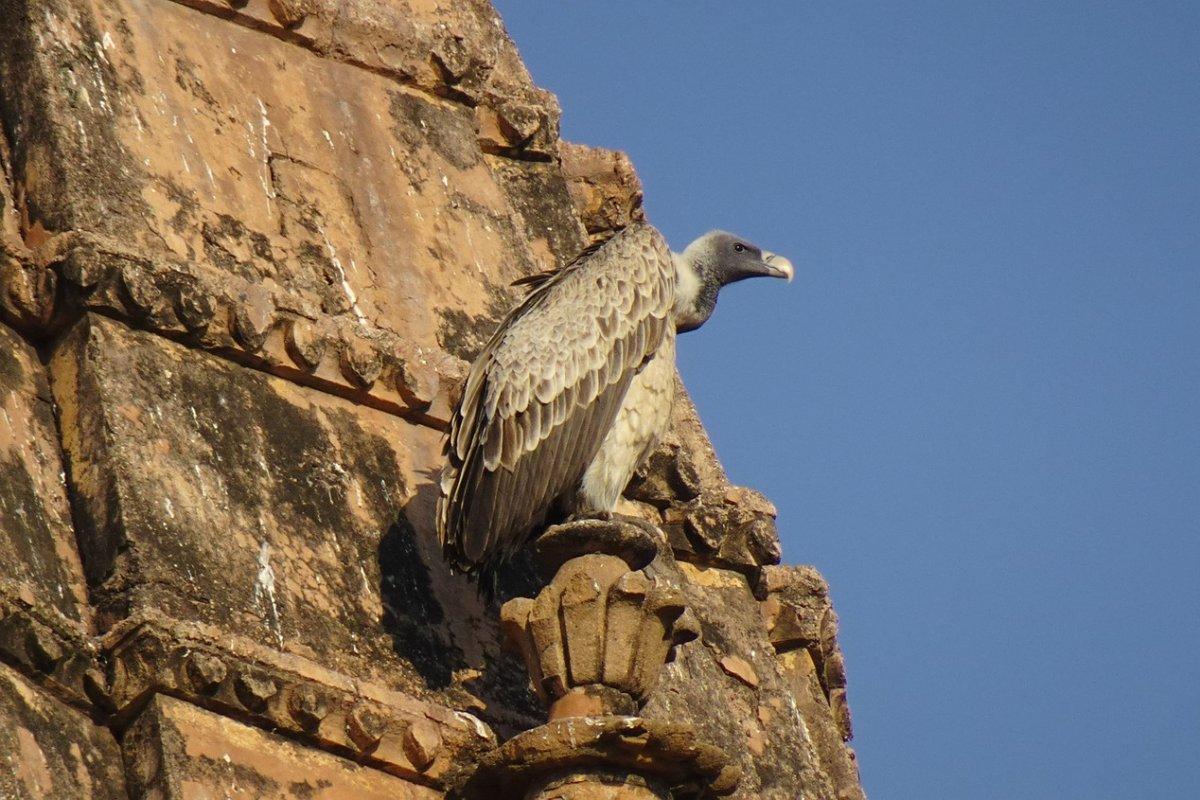
- Name: Indian vulture
- Scientific name: Gyps indicus
- Conservation status:
The Indian vulture is a species of vulture native to India, Nepal, and Pakistan. It is considered one of the critically endangered species in India since 2002, as its global population seriously declined, which is mostly due to poisoning that causes kidney failure.
Often gathering in flocks, it can be found in peninsular and Central India, breeding on hilly crags. Similarly to other vultures, it is a scavenger that mostly feeds on carcasses in order to survive, which it finds by soaring over the cities and savanna.
46. Olive ridley sea turtle

- Name: Olive ridley sea turtle
- Scientific name: Lepidochelys olivacea
- Conservation status:
The olive ridley sea turtle, also known as the Pacific ridley sea turtle, is the second-smallest species of turtle in the world. It inhabits warm and tropical waters, mostly in the Indian and Pacific Oceans, but also in some warm areas of the Atlantic.
This turtle is notorious for its synchronized mass nesting, where thousands of females gather together on the same beach to lay their eggs all at once!
47. Nilgiri langur
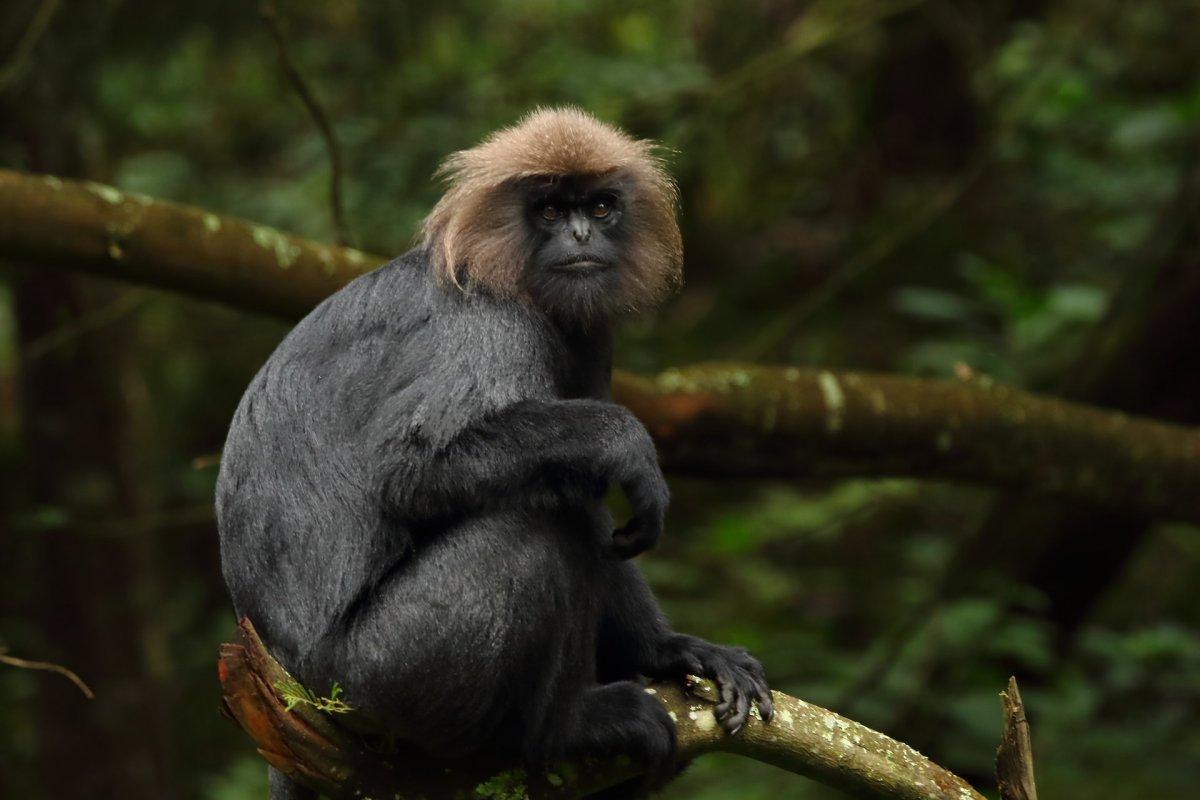
- Name: Nilgiri langur
- Scientific name: Semnopithecus johnii
- Conservation status:
The Nilgiri langur is a species of primate native to a very small area, the Nilgiri Hills in the southern part of India. It inhabits hilly and forested areas and has glossy black fur on its body with golden brown fur on top of its head.
This monkey’s diet is mostly made of leaves, shoots, and fruits. It is classified as vulnerable because of habitat destruction and poaching for its fur and meat, which is sometimes considered to have aphrodisiac properties.
48. Indian giant squirrel
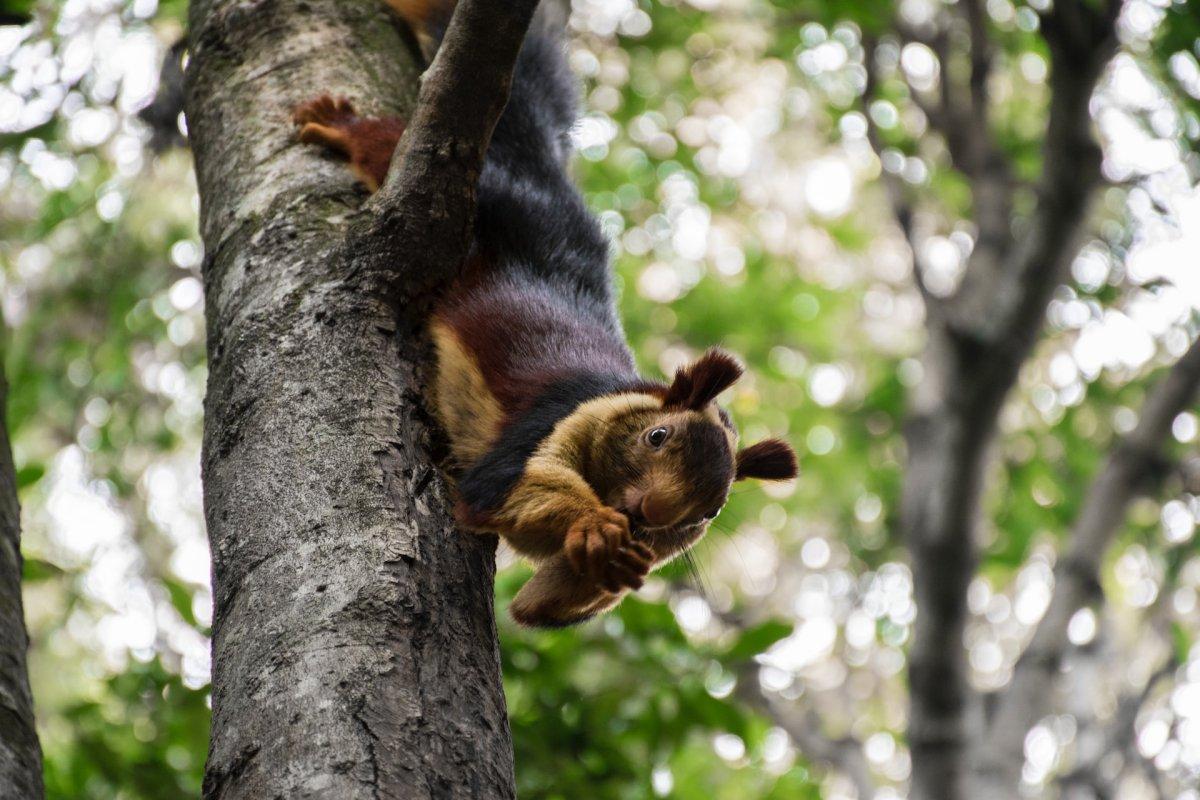
- Name: Indian giant squirrel
- Scientific name: Ratufa indica
- Conservation status:
Even squirrels look different and special in India, as the Indian giant squirrel, also known as the Malabar giant squirrel, shows. It is large, multi-colored, and endemic to woodlands and forests in India. Just like other squirrels, it is arboreal, diurnal, and mostly herbivorous.
This squirrel either lives alone or in pairs and builds large nests made of leaves and twigs, on thin branches so predators cannot reach them. Pretty smart, huh?
49. Royle’s pika
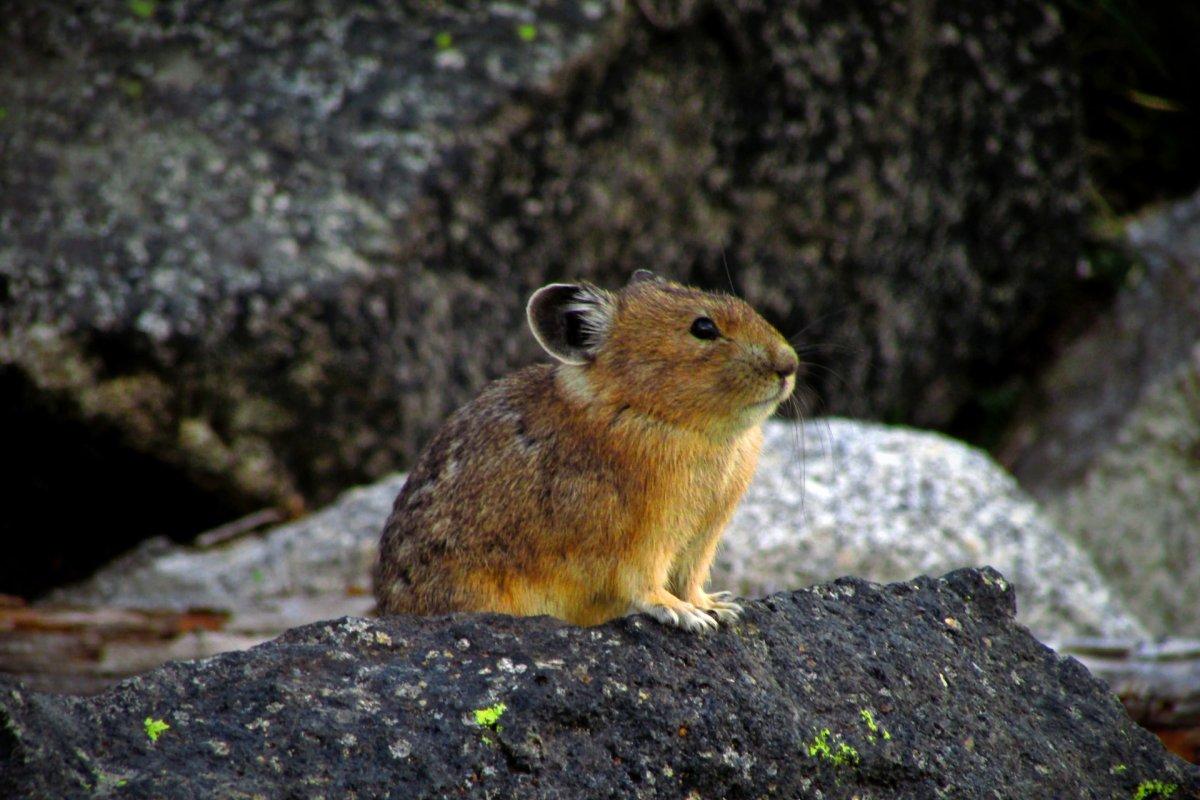
- Name: Royle’s pika
- Scientific name: Ochotona roylei
- Conservation status:
Royle’s pika, also known as the Himalayan mouse hare or the hui shutu, is a species of pika native to India, China, Bhutan, Nepal, and Pakistan. It mostly inhabits open rocky mountain areas or coniferous forests, foraging on the ground and resting during the day. It is indeed crepuscular and forages even more during the monsoon season when more food is available.
In order to escape from predators, Royle’s pika uses the rocky areas of the mountains and hides very quickly.
50. Large Indian civet
- Name: Large Indian civet
- Scientific name: Viverra zibetha
- Conservation status:
The large Indian civet is a species of viverrid native to southern and southeastern Asia. Despite being listed as least concern, its population is globally declining, mostly because of heavy hunting and trapping.
This civet is both solitary and nocturnal and spends most of its time on the ground, where it hunts for fish, lizards, frogs, insects, and birds, among others. It is protected in some countries such as Thailand, Vietnam, Myanmar, and Hong Kong, although it is most likely extirpated from the latter area.
—
So there you have them, these were my 50 animals found in India. I hope you enjoyed this list and that you learned something new today.
In case you want to learn more about the Indian wild animals, feel free to keep reading, as I still have lots of things to tell you about:
Endangered Animals of India
This is definitely the saddest part of the list, but it is very important to raise awareness. Because of this, let’s go through the list of endangered animals in India.
Here are the animals in danger of extinction in India.
- None
- Javan rhinoceros
- Resplendent bush frog
- Sociable lapwing
- Shevaroy hills earth snake
- Green eyed bushfrog
- and 109 more…
- Gee’s golden langur
- Tricarinate hill turtle
- Masked finfoot
- Spinetail devil ray
- Asian elephant
- and 253 more…
To see the full list of endangered species in India, head over to the International Union for Conservation of Nature’s Red List.
What is the National Animal of India?
The national animal of India is the Bengal tiger.
The Bengal tiger is definitely the most iconic animal in all of India. It is a symbol of might, power, and freedom and has long been part of local culture and folklore.
Some subspecies are known man-eaters, and this animal is truly a force of nature; revered and feared by local inhabitants, it has become rarer and rarer in the past few years.
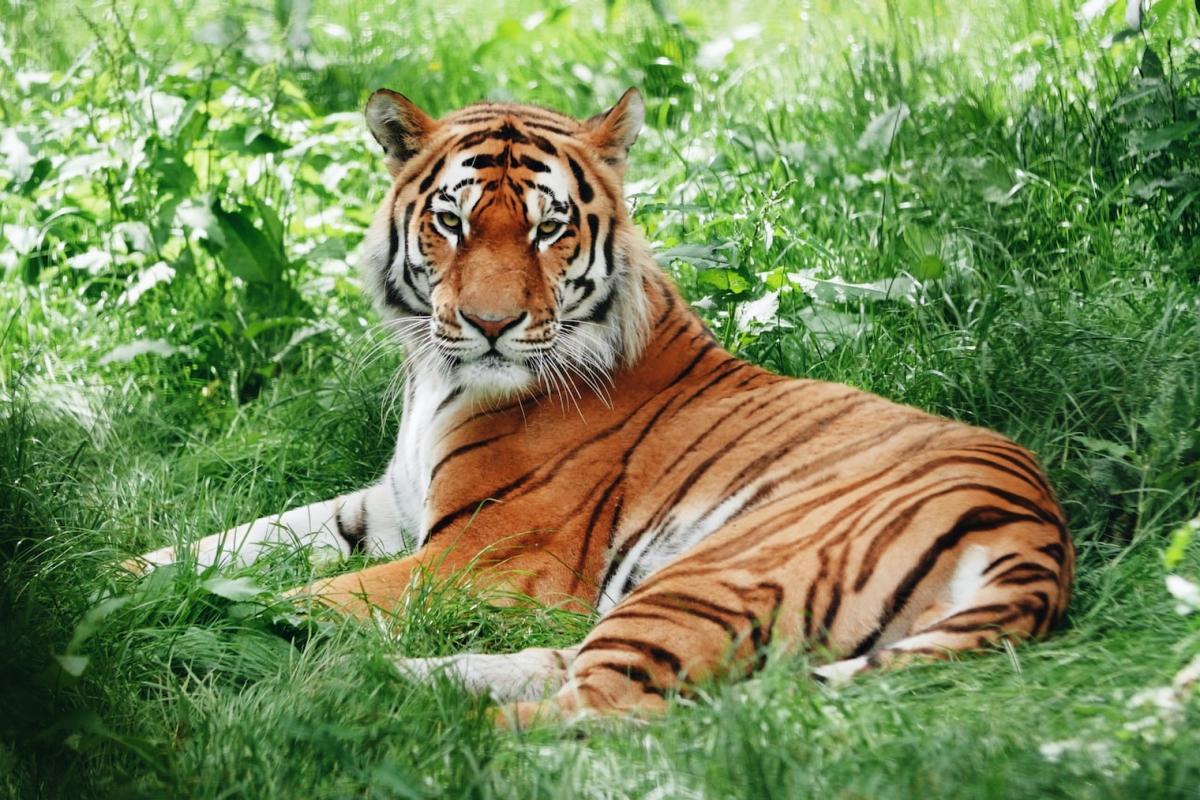
How Many Animals Native to India?
What is the diversity of native Indian species?
Let’s look at the total number of species of Chordata (mammals, birds, fishes, and reptiles).
Total number of animal species in India: 5,281 (15,319 in total in South and Southeast Asia)
More About Animals in the World!
Loved these wild Indian animals facts? Want to see what animals live in other countries?
Then check out these posts:
Or click here to see ALL the facts up on the blog! Spoiler alert: there’s A LOT of them.
Share the knowledge! Click on the buttons below to share information about these famous animals in India with your friends, and help them learn more about the world 🙂
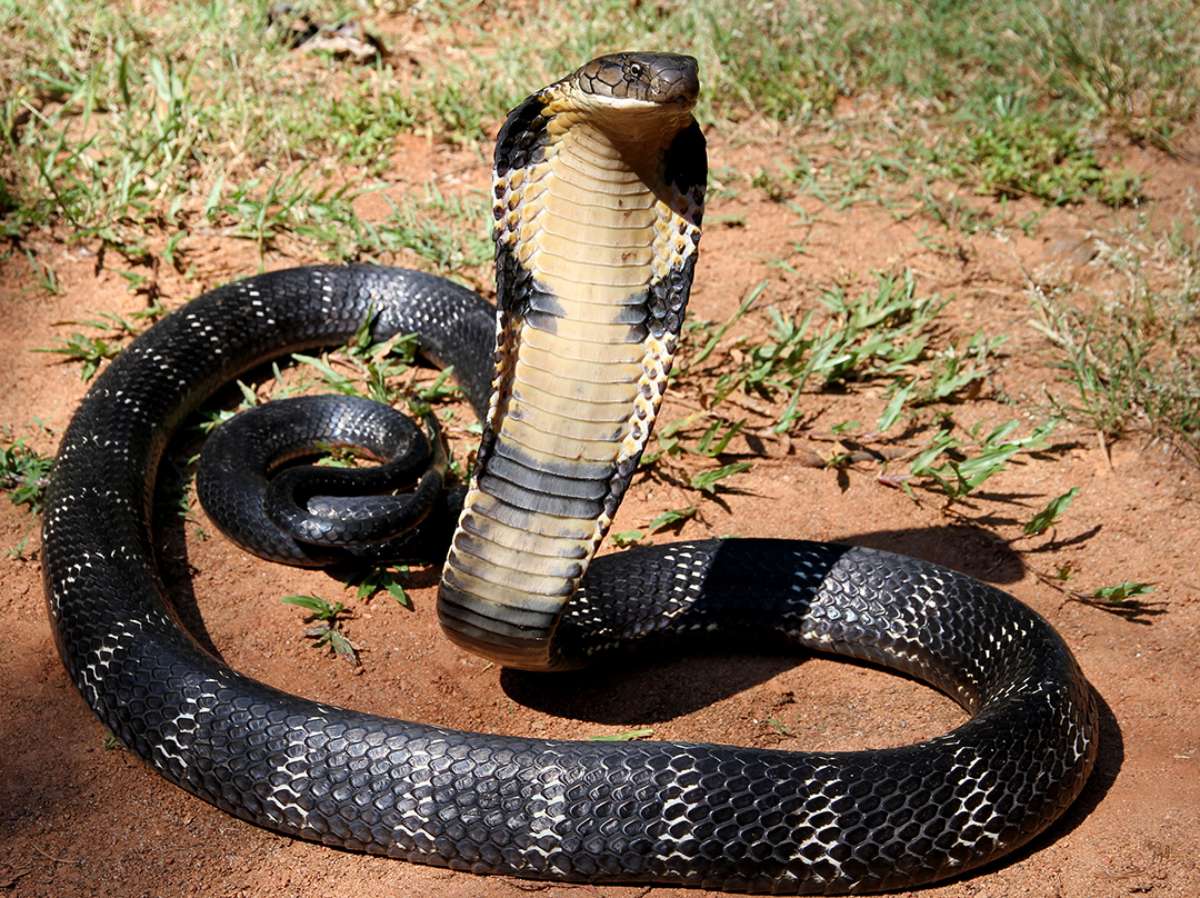
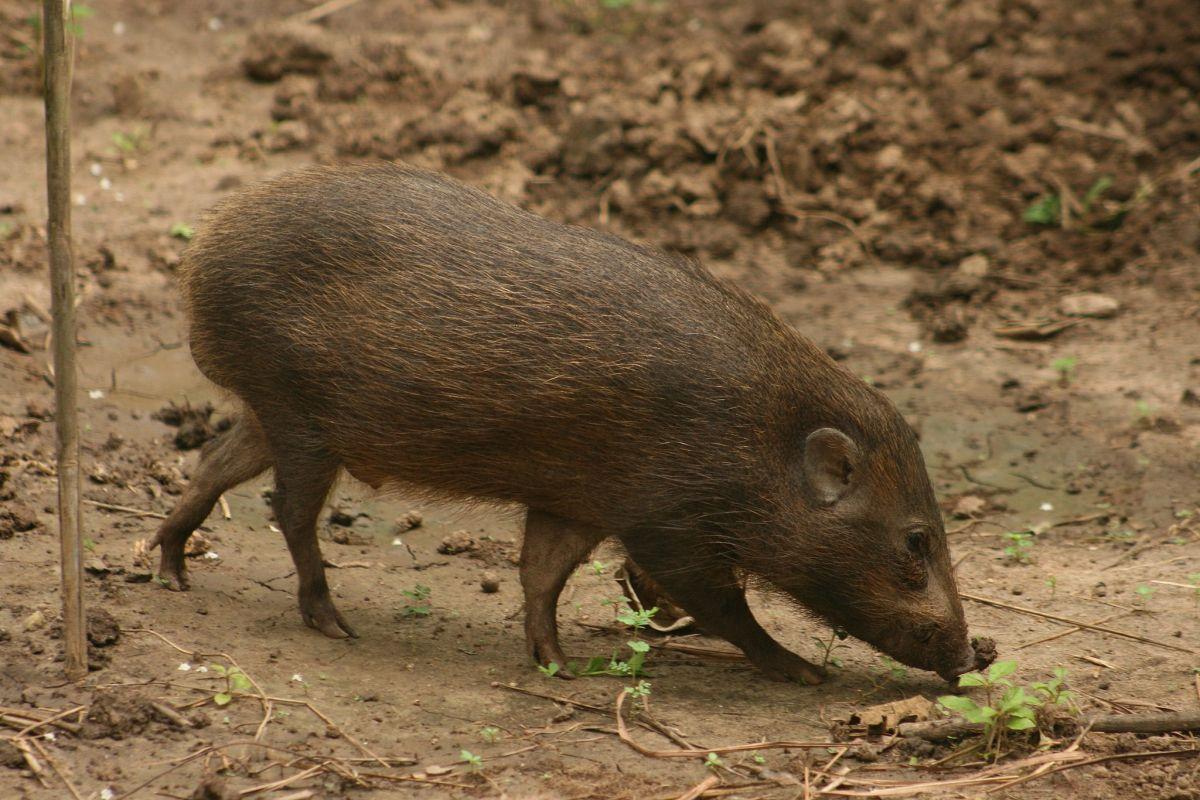
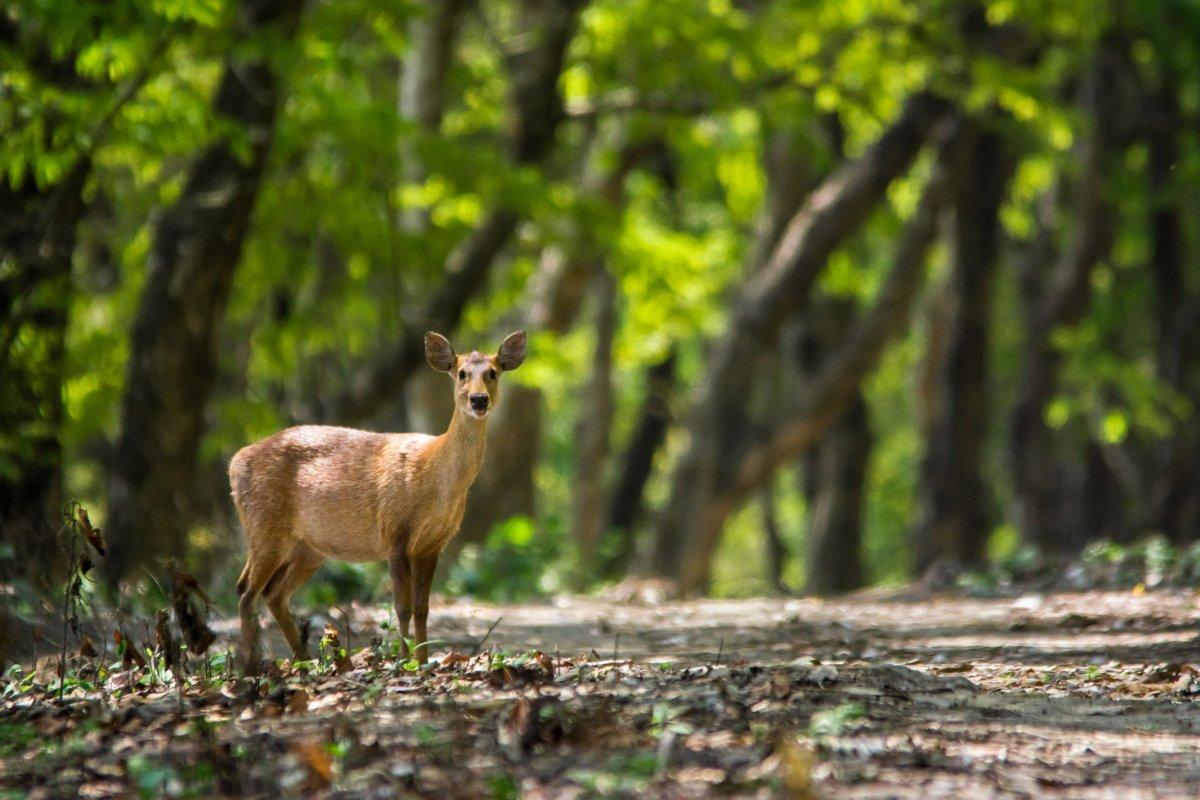
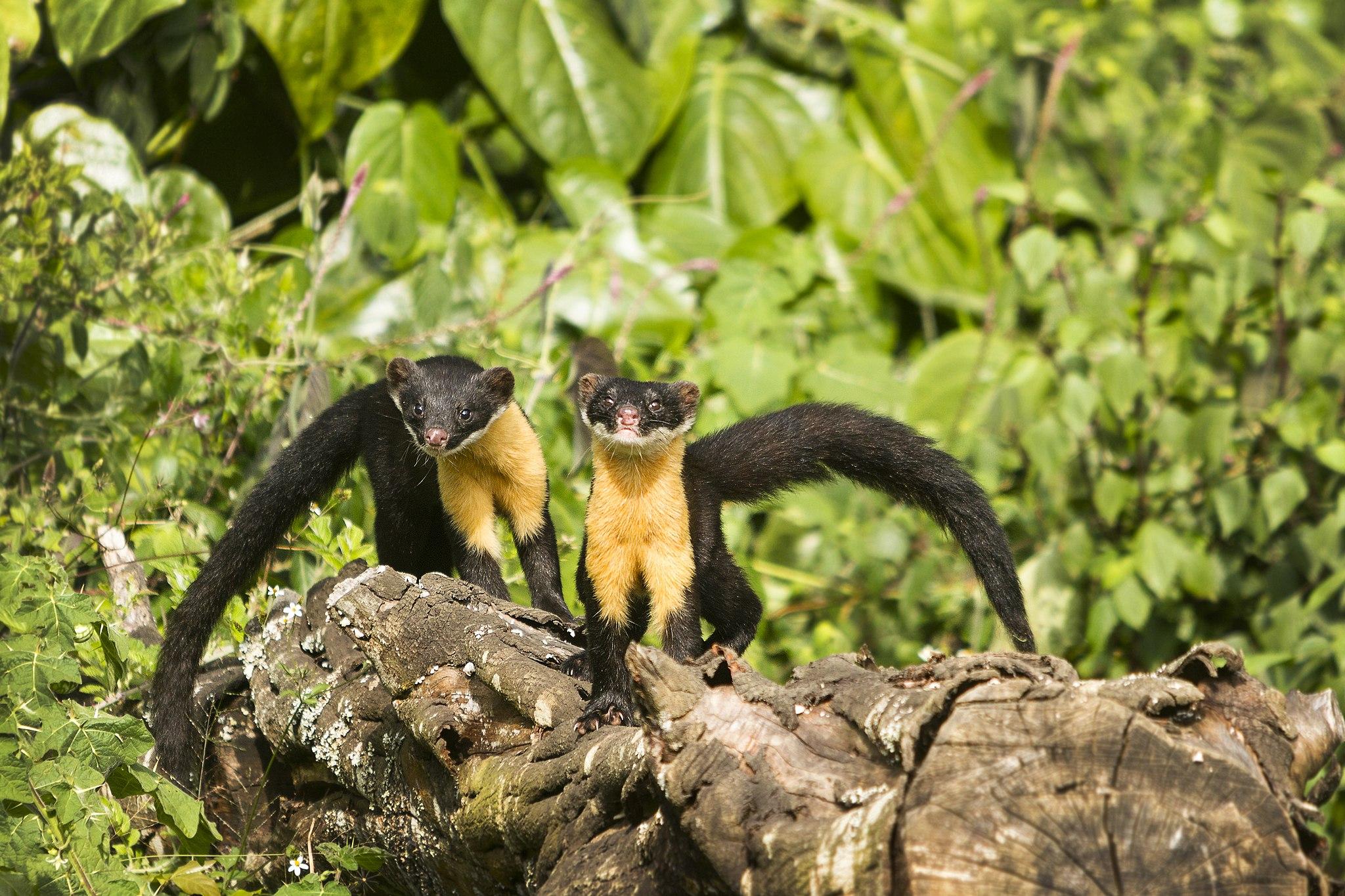
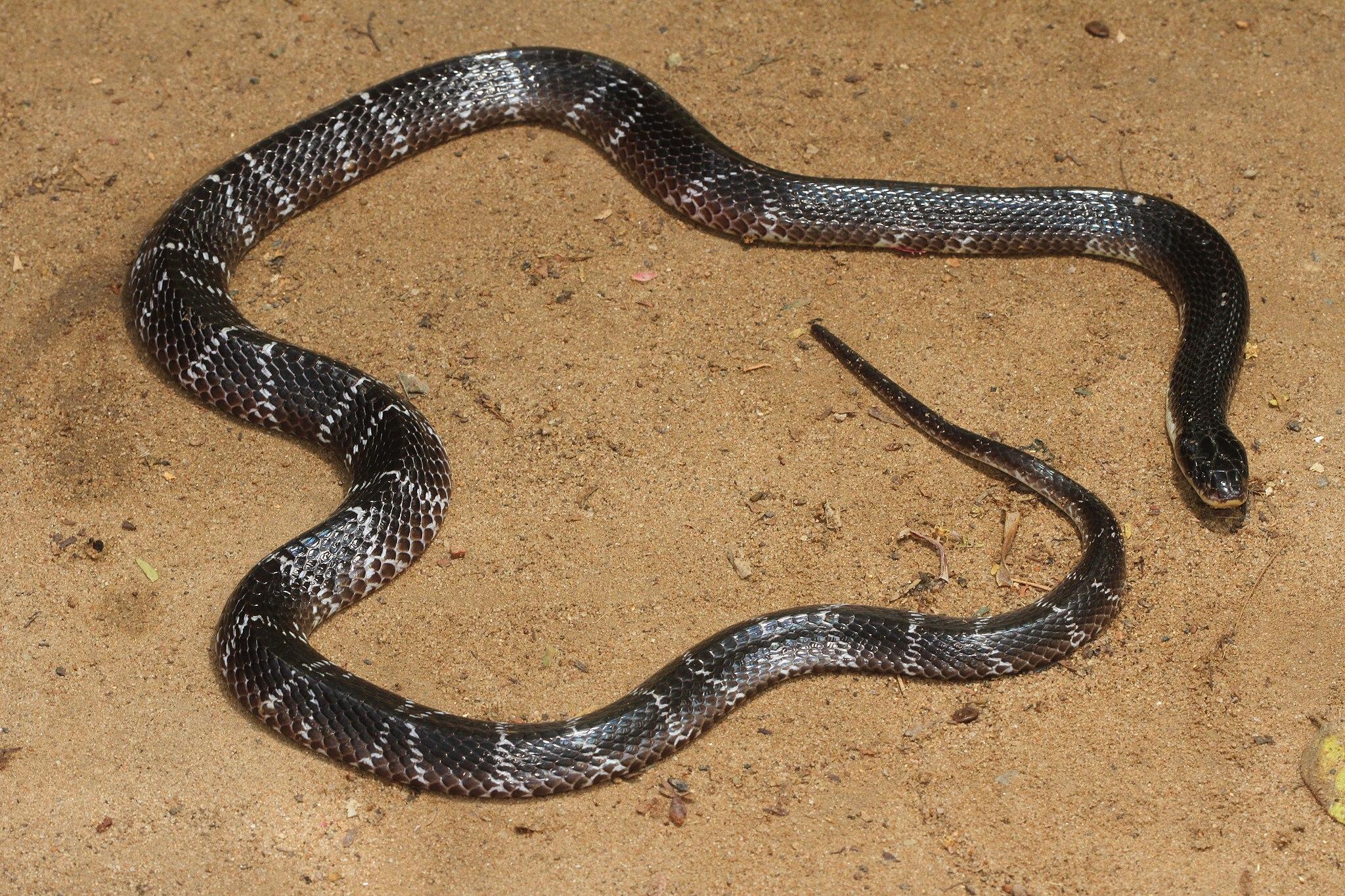
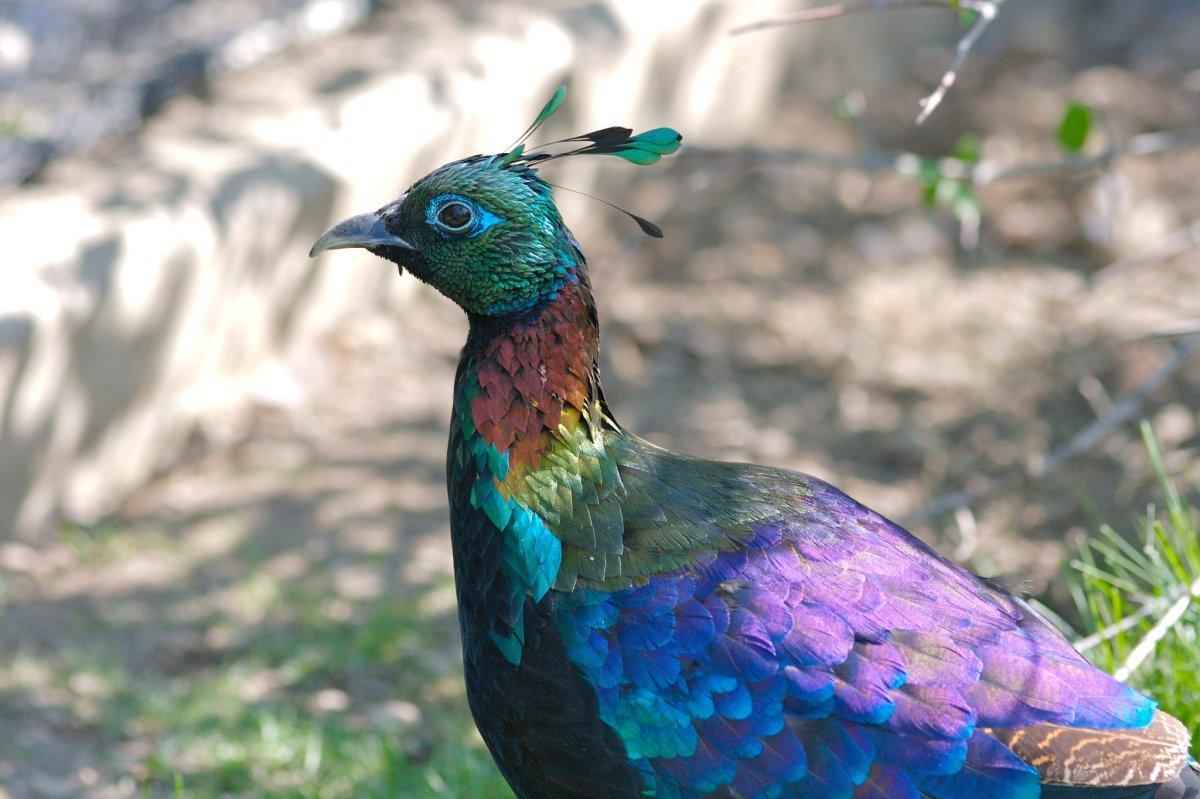
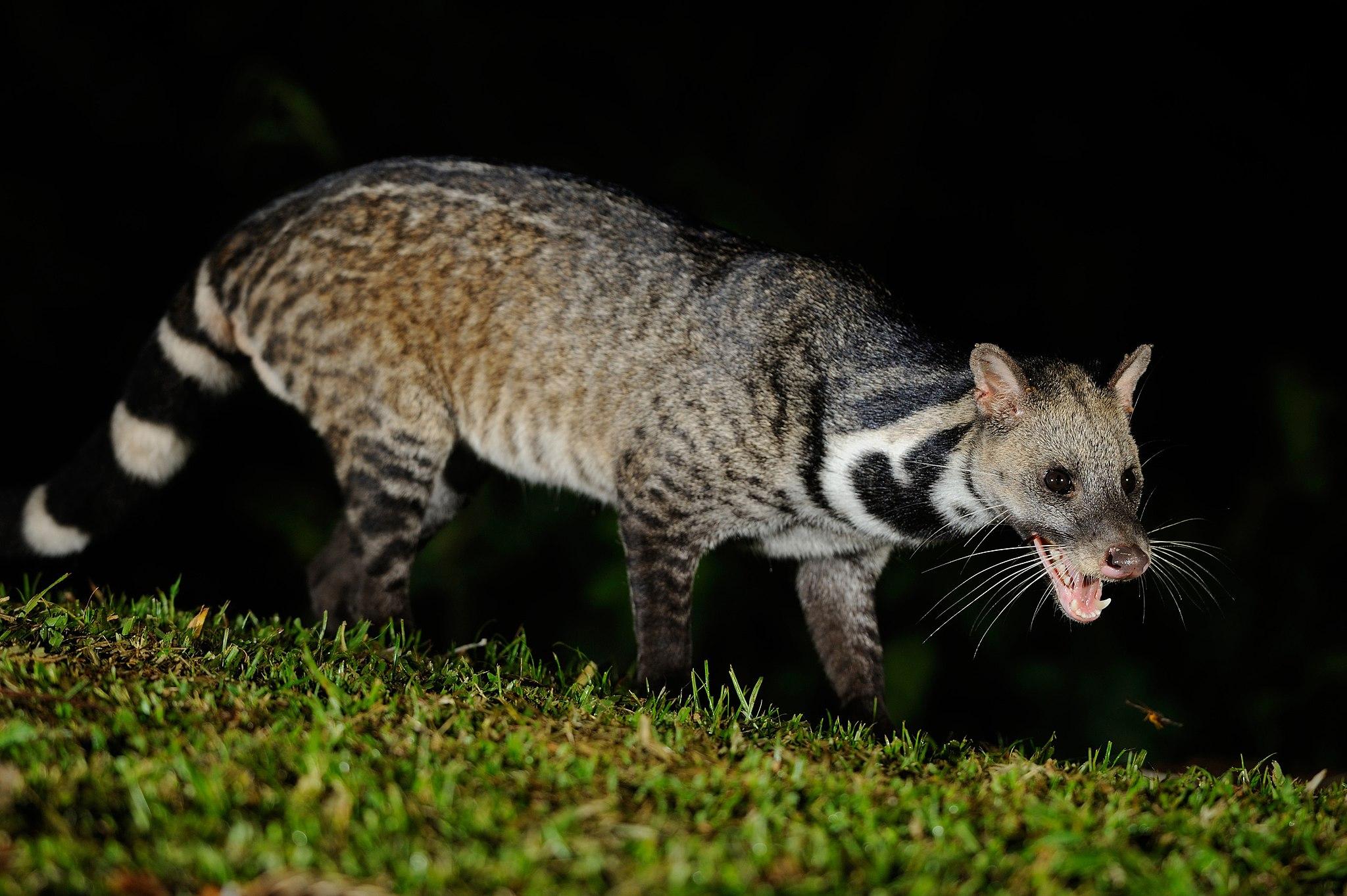

![16 Wild Animals in Saint Lucia [Wildlife in Saint Lucia]](https://www.kevmrc.com/wp-content/uploads/2022/08/16-wild-animals-in-saint-lucia.jpg)
![10 Wild Animals in Tuvalu [Wildlife in Tuvalu]](https://www.kevmrc.com/wp-content/uploads/2023/01/10-wild-animals-in-tuvalu.jpg)
![50 Wild Animals in Brazil [Wildlife in Brazil]](https://www.kevmrc.com/wp-content/uploads/2022/06/50-wild-animals-in-brazil.jpg)